
ARCHAEOLOGICAL DISCOVERY TOURS | JANUARY - MARCH 2025


SINGLE SUPPLEMENT UP TO PLACES AVAILABLE £650pp *


ARCHAEOLOGICAL DISCOVERY TOURS | JANUARY - MARCH 2025


SINGLE SUPPLEMENT UP TO PLACES AVAILABLE £650pp *
Dear Traveller
Welcome to this collection of tours in early 2025 covering some of the World’s most fantastic historic areas.
We are excited to bring you a number of new tours for 2025 as well as some returning favourites which we hope that you will enjoy. Amongst our new tours for 2025 we have tours to Rome and Oman as well as a thought provoking visit to Guatemala, Honduras & Belize where you can learn about and experience some of the wonders of the Maya from Dr. Nicholas James, author of “Aztecs and Maya”.
As well as our new selection of holidays we are pleased to present to you some unique opportunities to visit key historic locations throughout Europe, Asia and Africa. A perennial favourite tour takes visitors to Pompeii and Herculaneum where continued works reveal evermore about the past. Learn more about the Regio XI excavations in Pompeii and get exclusive access to the Cave of Sejanus as well as exploring the newly excavated House of the Leda.
Further afield we explore Africa and Asia. Perhaps learn more of the human origins in the Savannah, explore Petra with renowned expert Nick Jackson or visit Oman or Istanbul for a taste of Asia.
Whichever tour with Andante Travels you choose you can be sure that you will be with the experts. All our Guide Lecturers are experts in their field and will give you an insight into your chosen destination rarely experienced elsewhere along with your unique and exclusive access to areas not accessible by the public.
We hope you enjoy perusing this selection of adventures and look forward to welcoming you soon.
Happy browsing!
2025 SPECIAL OFFER DISCOUNT - SAVE up to £650pp*
Enjoy a saving on all our tours departing in 2025. See our tour pages for the saving you can make on each departure date.
Offer ends 31st August 2024.
PAY IN FULL - AN ADDITIONAL SAVING OF 10%
If you pay in full at the time you book your 2025 tour, you can take advantage of an additional 10% discount. Offer ends 31st August 2024.
£0 SINGLE SUPPLEMENT PLACES
We have over 150 places on selected tour departures in 2025 with no single supplement to pay, but when they are gone, they are gone so look out for this sticker on the tour pages.
£0 SINGLE SUPPLEMENT PLACES AVAILABLE
TERMS & CONDITIONS:
We reserve the right to withdraw special offers at any time and they are not valid for any bookings on private groups, travel agent bookings or Study Days.
2025 SPECIAL OFFER DISCOUNT: The discounts advertised are off the full selling price. Valid for new bookings made up until 31st August 2024 and on a limited number of places on each tour departing in 2025. *The discount of £650 per person applies to our South Africa & Great Zimbabwe tour departing on 31st March 2025. These discounts can only be combined with the other offers detailed on this page.
PAY IN FULL - AN ADDITIONAL SAVING OF 10%: The 10% discount is applied to the remaining balance after any discount, customer holiday vouchers or credit notes have been applied. Valid for new bookings made up until the 31st August 2024, on tours departing in 2025, and on a limited number of places on each tour departure. This discount can only be combined with the other offers detailed on this page.
£0 SINGLE SUPPLEMENT PLACES: There are a limited number of £0 single supplement places on selected departures. These places are also subject to hotel availability. This discount can only be combined with the other offers detailed on this page.
Winners of a Feefo 2024 Gold Trusted Service Award for excellence in customer service, also winning a silver at the British Travel Awards 2023 for the Best Travel Company to Italy/Western Mediterranean Islands. And, our very own John Shepherd won the Wanderlust World Guide AwardHistory & Culture 2023. Here’s to continued success throughout the year!


If you are interested in joining one of our tours and want to know more, please do give our Specialist Travel Executives a call today. They are ready to help with all of your questions.

Unearth history's treasures with Andante, the pioneering British authority on in-depth archaeological travels. Venturing beyond mere cultural excursions, we craft extraordinary journeys, granting you access to the world's most significant historical sites. With 24-hour support from our dedicated team and meticulously planned itineraries, rely on Andante for an unparalleled odyssey into antiquity.
• Keeping it small with a maximum group size of 18
• Insider knowledge garnered from nearly 40 years of touring
• Quality time on site – we don’t cut corners
• We only see the very best on tour and only add free time when it is in the best interests of guests to do so
• Tour Managers as well as Guide Lecturers so they can focus on informing
• Calibre of our Guide Lecturers - highly sought after for their in-depth knowledge
• Carefully thought-out programmes that follow a theme
• Excellent value – inclusive of all local transport, meals, and on most tours wine at dinner, no passing around a hat for tips as these are all included
• Individuality - we never treat you like a number, make you wear a badge or wave an umbrella at you

Rome has some new sites to discover. Added to our programme next year is the Parco Archeologico del Celio which opened recently. The museum houses the remaining fragments of the Forma Urbis Romae, the giant marble map of ancient Rome engraved in the 3rd century. The last time the remains of the ancient map were seen by the public was a century ago! Also included by popular demand is a trip to Tivoli to see Hadrian’s Villa.
Dr Nicholas James has had us all vying for a place on our new and improved Guatemala, Honduras and Belize tour with his descriptions of the deep blue water, dramatic mountains and lush cloud forests around Lake Atitlan – we have added two nights here to make the most of the Mayan culture in the area and those wonderful lake views.
Encouraged by the thought of star studded Arabian skies and rolling dunes, our Oman tour is now embellished by a trip to Wahiba Sands, a vast desert region inhabited by the Bani Wahiba, Al-Harthy and Al-Hinawy tribes in Oman. We shall spend the night at a luxury desert camp – enough to spark anyone’s spirit of adventure.
By the time you read this we will have finished curating our NEW tour to Vietnam, The Mekong & Cambodia so below is a little taster of what to expect.
Rome is one of the most charismatic and engaging of the great cities of the world and this tour is the perfect introduction to the ‘Eternal City’ in the company of archaeologist and historians who will bring to life the triumphs, tragedies and political intrigue that characterised the Roman Empire. We stay at the privately owned Albergo Santa Chiara in the very heart of the ancient city, the perfect base for exploring Rome. See page 12
Join our first departure on 21st March 2025
Oman has been a crossroads of commerce for millennia and its archaeology has only recently begun to be understood. During this tour we travel from the mountains of Muscat to the beaches of Salalah, we explore the hub of Classical Arabia Felix, the great incense city of Sumhuram with a special drive out into the Empty Quarter to take us to the site of the lost city of Ubar, entrepot of the Frankincense trade. See page 26
Join our first departure on 31st January 2025
The juxtaposition of extreme cruelty and high cultural sophistication in the Maya world takes modern visitors by surprise but this enduring mystery of a magnificent civilisation, compounded by exotic jungle surroundings, make for a thrilling ‘page-turner’ of a tour. Much of Central America is still covered in lush rainforests as it would have been in most of the Maya period, so we are in a land of quetzal birds and jaguars, of volcanoes, lakes and waterfalls. See page 42
Join our first departure on 12th February 2025
Mysterious cities, atmospheric forests and colonial grandeur await in these evocative parts of southeast Asia. Home to some of the world’s most iconic archaeological sites, our expert Guide Lecturer will accompany us during our journey back to the past as we wander ruined temple sites, explore collections housed in great museums and discover breath-taking architecture. This 18-day tour includes a relaxed week cruising up the Mekong River, from Ho Chi Minh City along the Chao Bao Canal to Siem Reap, stopping at villages and workshops along the way, as we travel to Cambodia.
To secure your place on the first departure of this new tour departing on 23rd March 2025, call our team on 01722 282 610
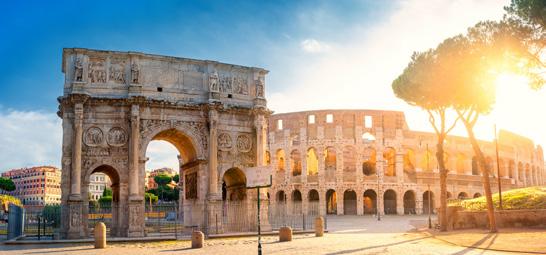
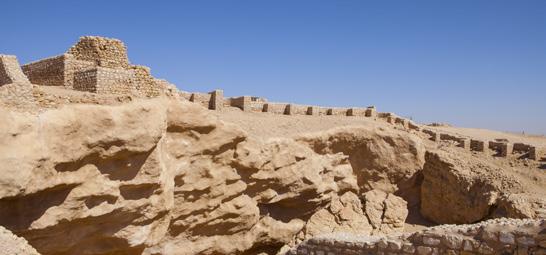
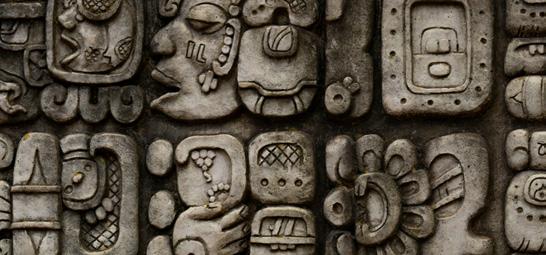

What makes an Andante Travels tour a cut above the rest? The simple answer is our expert Guide Lecturers. They are not just guest speakers who rely on local guides to point the way. Our outstanding team of engaging presenters will lead you through the sites you see, focusing on the detailed indicators of the past, explaining how things work and what a miracle of human ingenuity they represent. And they are your travelling companion, part of the group, there at all times to join in the laughter and chat, your expert on hand to converse with and put those all important questions to. Guests who travel with us frequently tell us that it is not only the high quality of guiding they receive but also the informality and easiness of travelling with an Andante Lecturer which keeps them coming back.

Nick Jackson, one of our renowned expert Guide Lecturers, can be found at the helm of our best-selling Petra – Jordan and the Desert Fortresses tour and he has revealed that while it is wonderful to take guests to this legendary site, there is one thing that most visitors don’t notice and he wants to point it out as it’s such an important aspect. On our Petra tours, it’s something you won’t miss. Here’s more from Nick Jackson. Petra in Jordan is a world-class destination for archaeological enthusiasts and history lovers alike, and a tour here is a truly unforgettable experience. Over the years, Andante Travels has pioneered innovative itineraries reaching parts of Jordan that other companies didn’t visit – until we did. We also led the way to changing how Petra should be best explored and came up with a simple solution – you need two full days there to do it justice.
“There is no more fitting a finale to an Andante Jordan and Petra tour than arriving at sunset ready to explore Petra. Despite the fact all guests are familiar with images of some of what they will experience the next day (and the one after that), the sheer majesty and mystery of this huge archaeological landscape and its peoples never fails to impress. But there’s more, including one smallish but beautiful thing, that very few visitors even notice. To me, it sums up Petra in one carved relief.”
We are on more solid ground searching for the Nabateans when we look at the geopolitics of the Old Testament Iron Age (1st M BCE). The world of Israel, Judah, Ammon, Moab and Edom. The southern borders of Edom would have been the interface where nomadic Nabateans met the settled Iron Age Holy land. Petra proper, and several other strategic sites in the area, were initially Edomite settlements. The relationship between Edom and the Nabateans seems to have been more peaceable than with its immediate western neighbours (‘Over Edom I will cast out my shoe’ Psalm 60).
The 6th century BCE Babylonian sack of Jerusalem allowed Edomites, who might well have allied themselves with Nebuchadnezzar, to move west and control more of the areas where the hugely lucrative Arabian trade routes cut through the Negev desert fringe to the Mediterranean. The origin of this trade was increasingly controlled by the Nabateans.
Babylonian rule disintegrated Edomite influence over her old southern border, and by the 4th century BCE Nabateans controlled Petra – making it a safe, mountain top, well-watered depot at the end of their strenuous desert crossings. Its new name was Rakmu.
As Hellenism replaced the power of Persia as the regional controlling force in the 4th century BCE, and itself started to fragment in the 3rd century, it was then the Kingdom of Petra was carved out, and the city built from the living sandstone. Imagine, just about everything we see in Petra was created in less than 200 years.
What were the factors driving this change? Income and a chance to increase regional power and therefore increase income was perhaps among the most significant.
There are several observations on Nabateans running through classical authors accounts, and here we need to add Josephus, a contemporary source. Still seen as the ‘other’ by the Hellenised and Roman east, a few Nabatean practices strike our sources as odd. Burial customs and hearsay talk on male and female relationships for example.
Descriptions of the structure of the elite, for instance, tell that the ‘King’
served his guests (something that is entirely acceptable, even required, for the honour of a host in today’s Bedu societies) but raises the Hellenistic eyebrow. This fits well with the traditional nomadic origins of the Nabateans themselves.
As the Nabateans absorbed more foreign influences, the hospitality and tribal structure aspect of their culture they kept. Other aspects they allowed to change.
All sources agree on one thing though, Nabatean business acumen was an essential trait, as was their keenness to increase wealth. Taking advantage of collapsing Seleucid control and the resulting chaos caused by the Maccabean revolt, Nabateans seized control of significant chunks of Jordan, southern Syria and Israel.
It was this that led to a massive reorganisation of Petra and a rapid increase in the complexity of the Nabatean socio-political, economic and cultural world. Petra grew into a permanent centre for administration and defence of this new kingdom, and the royal home of the Kings and Queens that headed it, during life, and after.
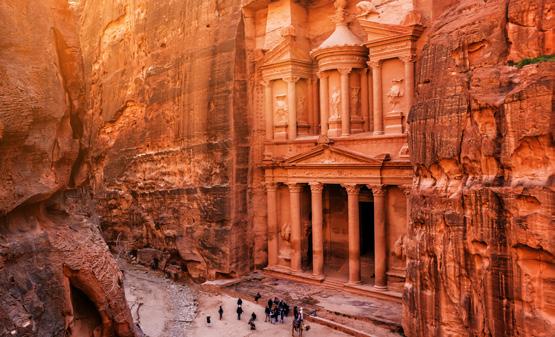
Travel takes us out of our comfort zones and inspires us to see, taste and try new things. It constantly challenges us, not only to adapt to and explore new surroundings, but also to engage with different people, to embrace adventures as they come and to share new and meaningful experiences. It can be daunting when travelling alone but with Andante Travels, you are never alone unless you choose to be.

Our tours are inclusive, informal and fun and Andante guests are some of the most interesting people you could care to meet. Travelling in a party of people who share your interests is an enriching experience. Friendships are quickly formed – and some last for decades with guests meeting up long after their tour has returned and arranging to travel together on future adventures.
As part of an Andante escorted tour, you will have the reassurance that our tour staff are very much part of the group. Unlike some guides who only engage when leading and make themselves scarce as soon as the opportunity arises, Andante staff are with you every step of the way, sharing the same experiences, enjoying the same meals (and often the same tipple at the bar), and laughing at the same absurdities that can happen on tour (a tortoise holding up the bus springs to mind!). Meal
Over half of our guests travel solo and many of them tell us that single supplements across the travel industry, including ours, are sometimes too high. They feel disadvantaged for travelling alone. We listened, and we negotiated over 150 places on a selection of our tours in 2025 with £0 single supplement.
What’s more, we offer double rooms (for sole use) as standard for our solo travellers so you will never be stuck in a room with just a single bed in a distant corner of a hotel. And our Tour Managers are experts in supporting solo travellers on the road. This is all part of our commitment to become the very best special interest travel company for solo guests. Look out for this sticker on the tour pages.
£0 SINGLE SUPPLEMENT PLACES AVAILABLE
times are therefore never solitary, evenings are never dull and our tours are delightfully companionable. Regardless of whether you are travelling with friends, with a partner or solo, rest assured you’ll be at the heart of it all with Andante.
We may travel as a group but we always respect the individual. There is no badge-wearing, roll-calling, umbrella-waving or whistle-blowing on Andante tours. And, wherever possible, we build time into our site visits to allow our guests the freedom to explore and make discoveries of their own. So, if you want to spend some time sketching, writing, meditating on a mosaic or settling down for a chat and a coffee with new friends, we are the travel company for you.
Choose to explore incredible sites in the company of our expert guides and you’ll see that our tours are well suited to solo travellers.
Pompeii, Herculaneum & Classical Campania
Departing: 27th January & 17th March 2025 – p8
Romans on the Bay of Naples
Departing: 3rd & 31st March 2025 – p18
Lake Garda & the Cities of Veneto
Departing: 31st March 2025 – p16
The Romans in Algeria
Departing: 16th February 2025 – p28
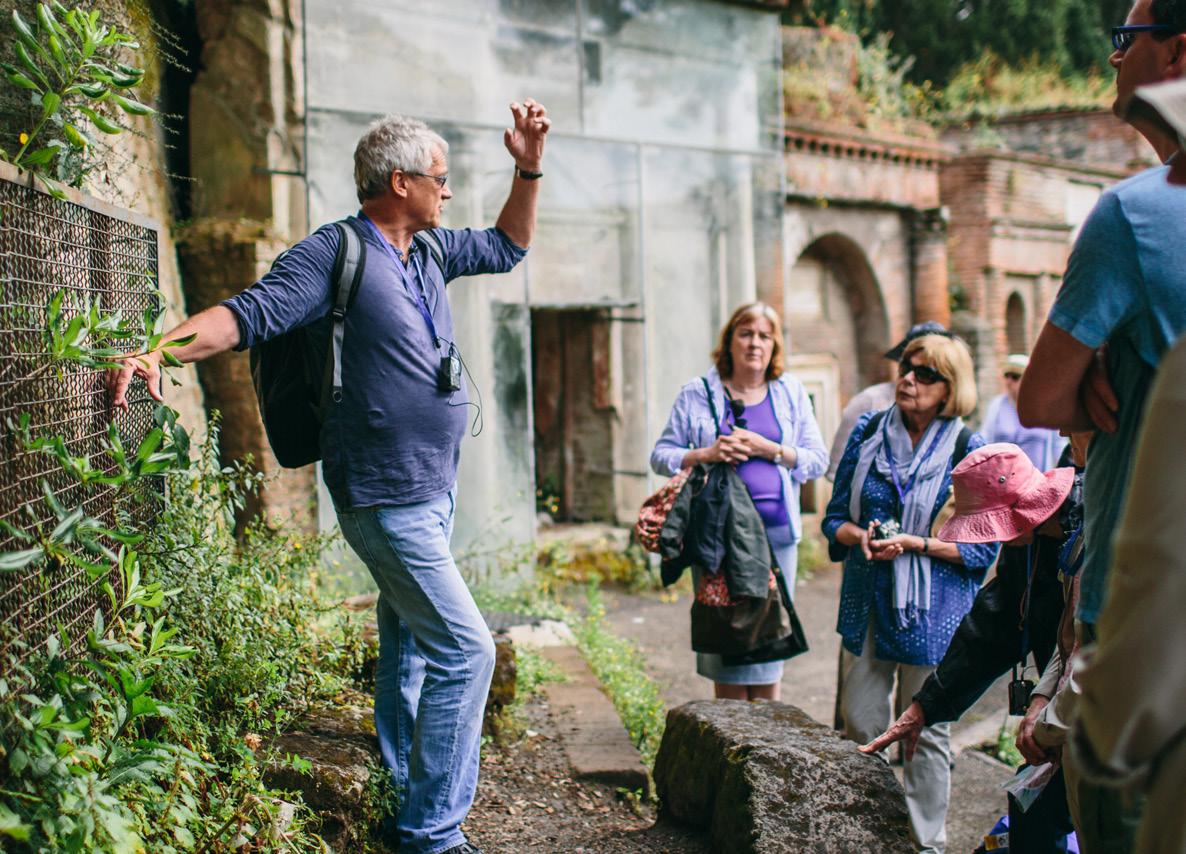

We have designed a grading system to help you understand how strenuous or relaxed your tour is likely to be. The levels are determined by components that make up a tour, such as distance and terrain walked, the driving distances covered and each day’s length – from the moment you leave the hotel to your return.

Look out for this panel on all our tour pages
Level 1 - Gentle A tour that is determined as gentle will have a relaxed pace, with little walking and less exertion where travel and day length are concerned.
Level 2 - Light On light tours, anticipate mild walking with a mostly relaxed pace. There will be more visits and travelling than on our gentle tours, but not by much.
Level 3 - Moderate A decent level of fitness is required for our moderate tours. There could be walking between sites, more standing and more travelling to encounter.
Level 4 - Active If you choose an active tour, come prepared for longer days – and ones that fit more in. More walking, bigger distances covered and more energy!
Level 5 - Challenging For challenging tours, you’ll need to be physically fit. Days could include long drives, hikes and multiple visits, meaning they’ll be lengthy and tiring.
8 DAYS FROM £2,770pp
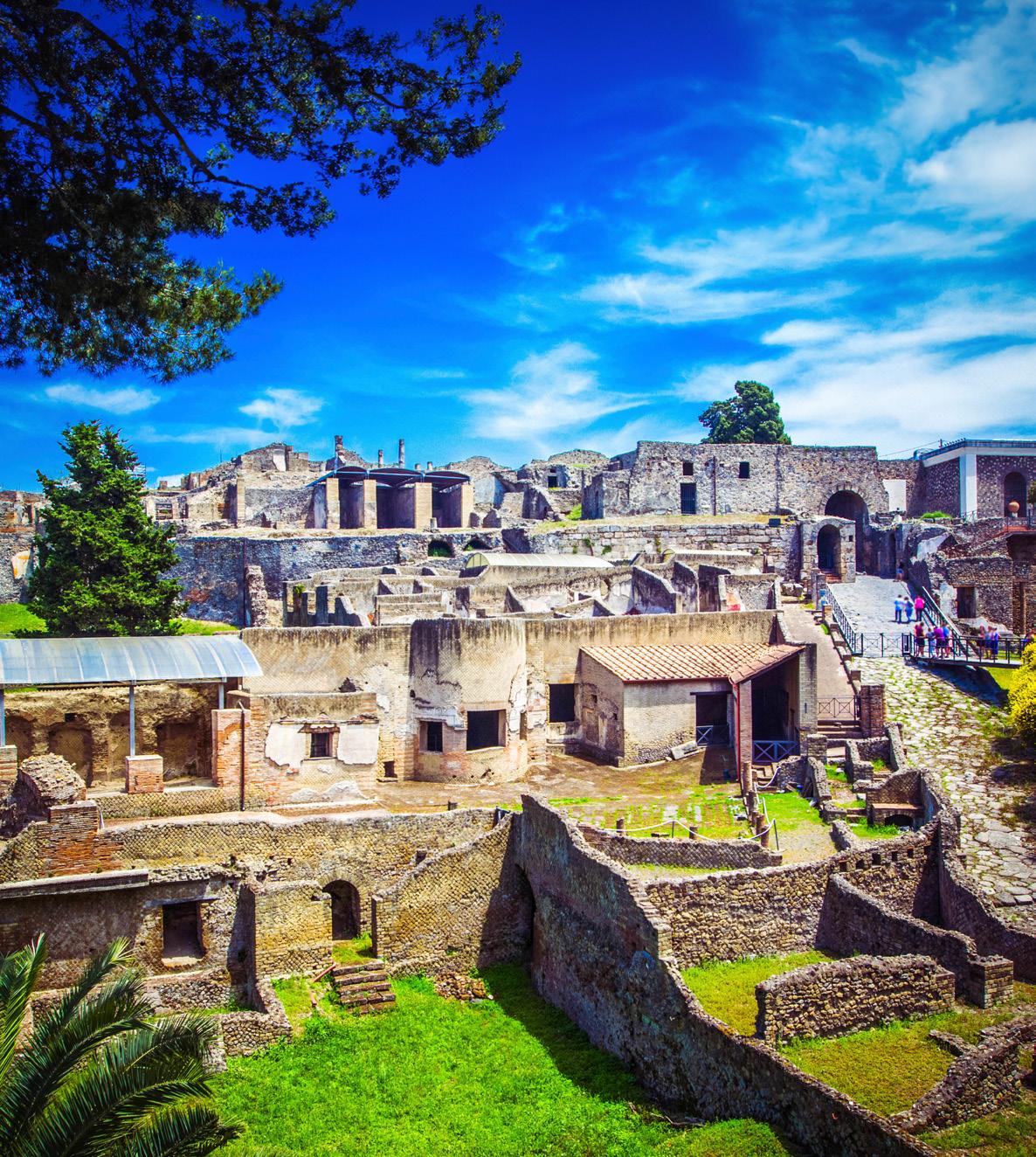
£0 SINGLE SUPPLEMENT PLACES AVAILABLE
Activity Level
“ Exceptional experience! This is my fourth Andante tour and the best yet”
Nowhere in the world gives deeper insight into Roman life than the dramatic seaside towns of Pompeii and Herculaneum. Before the cataclysmic eruption of Vesuvius these were thriving, lively seaside towns. Pompeii, a trading town equipped with many bars, shops and brothels, while neighbouring Herculaneum was an affluent and elegant town. All this came to an abrupt halt, however, one autumnal day in AD 79, when Vesuvius - which had done little more than rumble for years - erupted with incredible force. Two thousand years later, the sites of the Bay of Naples confront the modern visitor with a vivid, haunting immediacy like nothing else in the ancient world. In some cases we even know the names, professions and personal histories of the people who owned the villas and shops we visit. The preservation of Herculaneum, Pompeii and its surrounding sites is remarkable and the archaeology beyond compare, which is why we have been leading tours here for over 30 years. And this is an exciting time for visitors as new discoveries are being made and new houses opened. Walk with us as the Romans did, from amphitheatre to baths to forum, as our Guide Lecturer conjures an evocative picture of the everyday life of these prosperous Roman towns.

• Enjoy visits to off the beaten track villas at Stabiae
• Private access to the Cave of Sejanus (Grotta di Seiano) and the adjoining Villa of Pausilypon with its dramatic coastal views
• Explore the newly excavated House of the Leda and other newly opened houses
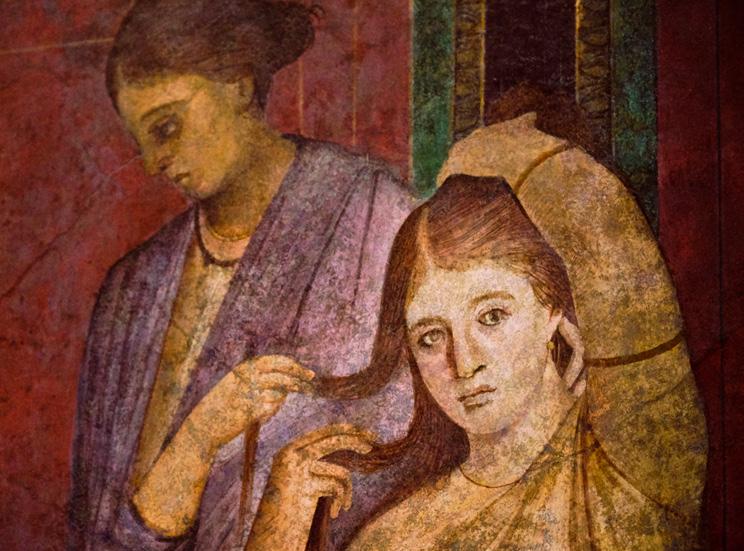
Today we fly from London to Naples and then we transfer to our hotel on arrival.
Our day begins with a visit to the fascinating site at Paestum, ancient Poseidonia. Long before the Romans came, this was a thriving Greek city that was part of greater Greece from the 6th century BC. After lunch, we visit the Paestum Museum, famed for its archaic metopes and its painted tombs. We will also be able to visit the magnificent Store Rooms of Paestum.
Day Three | Pompeii
We devote the entire day to Pompeii. No other site compares in revealing details of daily life in a Roman town. We visit some of the most well-preserved buildings as well as an amphitheatre, theatre, forum,
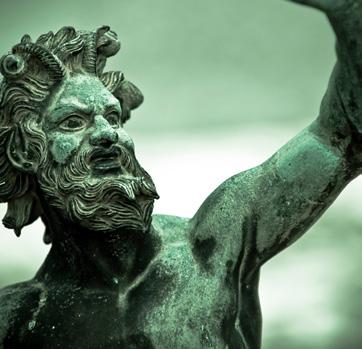
bath-houses, bars and even brothels. Fountains in the street are worn from where countless people rested their hands to take a drink and Roman graffiti can still be seen on the walls. Travelling via the best routes to avoid the crowds, we visit some houses that are newly reopened to the public.
Our first visit of the day is to the fabulous National Archaeological Museum in Naples, home to exceptional collections of artefacts. After lunch, we move on to Pozzuoli and visit one of the world’s most impressive amphitheatres. Later, we are granted private access to the Cave of Sejanus, an impressive tunnel dating to the age of Augustus, which gives access to the lovely seaside villa of Pausilypon. D1uring our visit here, we can see a theatre and odeon, built at a later date.
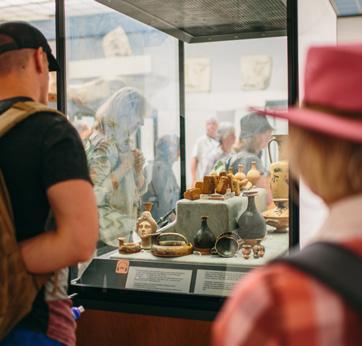
John Shepherd
Winner of the Wanderlust World Guide Award - History & Culture 2023, John has worked extensively in the field in Europe as an archaeologist, including France, Italy and Bulgaria. Join John on our 27th January departure.
Dr Doru Bogdan


A researcher and lecturer at the University of Alba Iulia in Romania, Doru is a specialist in Roman archaeology and has also supervised an array of fascinating excavations. Join Doru on our 17th March departure.

Go off the beaten track today to the villas of Stabiae, an exclusive Roman resort for the very wealthy. The vast Villa San Marco, with its swimming pool and bath complex, is one of the most opulent along this coast and it remains very impressive in its scale. Subject to renovations being completed, we hope to visit the Villa Arianna, with its wonderful frescoes and fabulous views over the Bay of Naples. After lunch we visit the Archaeological Museum of Castellammare di Stabia Libero D’Orsi which opened in September 2020 specifically for the exhibition of the many important items found in the region of Stabia. There are a large number of finds on display, some never before exhibited in Italy, including frescoes, inlaid floors, stuccoes, sculptures and tableware. Continued...
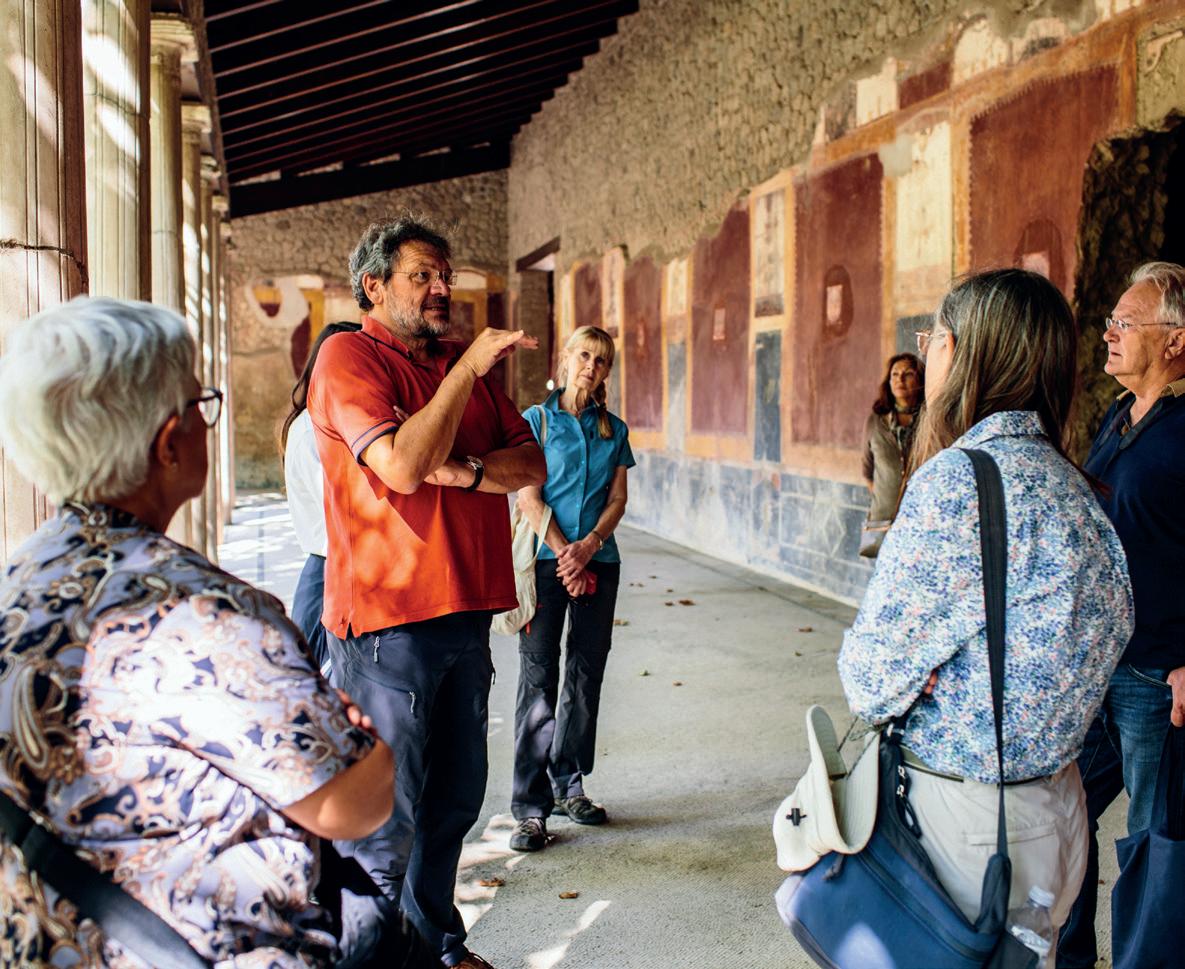


This morning we head to Herculaneum, which perfectly complements a visit to Pompeii. This seaside city was buried to a significantly greater depth than Pompeii — under 23 metres of pyroclastic to be exact — perfectly preserving every-day objects as well as houses up to their rooftops. In addition to the site, we explore the Antiquarium, newly opened after 44 years, and which houses precious articles found along Herculaneum’s sea front, including a well-
“ It was my first tourand it was fascinating, fun, a great pace, easy, delicious, comfortable... I was really delighted with it all… we laughed and we learnt”
preserved boat. after lunch we visit Boscoreale where we visit the Villa Regina, discovered in the late 20th century while digging for the foundations of council housing. In contrast to the opulent villas we have seen on other days, this is a modest small holding which provides us with evidence of how ordinary people lived. Boscoreale is a locality north of Pompeii located on the slopes of Vesuvius, identified by some with the Pagus Augustus Felix Suburbanus . With the inauguration of the Great Pompeii, in
The Great Pompeii Project was initiated in 2012 with the intention of better conserving the archaeological site of Pompeii. A major threat to its security is the embankments of unexcavated areas that are next to those already excavated. Addressing the water damage and associated erosion of these has been identified as a priority in preserving the site and making as much of it as accessible as possible. The more usual restoration of already excavated houses, including their decoration, is included in the work of the project so that a greater number of buildings in the site of Pompeii are safe to be explored by the two million people who visit it each year. The Project’s focus on Regio IX in recent years has brought to light exciting finds and at the same time shown how an interdisciplinary approach has given a new dimension to our understanding of life in Pompeii at the time of the eruption as well as of the eruption itself. Among these finds are three skeletons, whose manner of death is as gruesome as the initial evidence might suggest but in a surprising way; a domus from the Samnite period, repurposed into a bakery, which has shown us a small detail about how the Pompeian’s were experts at reusing and recycling materials; seismological evidence that confirms to modern volcanologists the accuracy of the account written by the eye-witness Pliny the Younger for his friend, the historian, Tacitus.

Your comprehensive expert guided tour includes
•
• Field notes
• All taxes & gratuities
Included travel
•
• Accommodation in the Hotel Scapolatiello or similar
October 2023, the Antiquarium of Boscoreale was reopened with a room dedicated to the excavations underway in the suburban villa of Civita Giuliana, with the ceremonial chariot found there in 2021.
Day Seven | Vesuvius - Oplontis
Today, we ascend to the great volcanic crater of Vesuvius. The majority of our journey will be by bus, but the final part requires a short walk, which will be well worth the effort. The walk starts at Monte Somma, the crater of the AD 79 eruption, where we grasp the scale of it. After the ascent and peering into the crater being forged since the ancient eruption, you will see fumaroles and the
layers of previous eruptions, while walking around the perimeter of the crater affords magnificent views over the Bay of Naples. On good days, you can even make out Pompeii. After lunch, we will continue on to the impressive villa at Oplontis, which boasts sumptuous frescoes, a bath complex, an enormous swimming pool, and interesting slave quarters. This villa was supposedly owned by Emperor Nero and was both destroyed and subsequently preserved by Vesuvius’ eruption.
Day Eight | Cava de’ Tirreni - Naples - London
After breakfast, our tour ends and we catch our return flight back to London.
Culinary inclusions
• 7 breakfasts, 5 lunches & 7 dinners
•
7 DAYS FROM £3,990pp
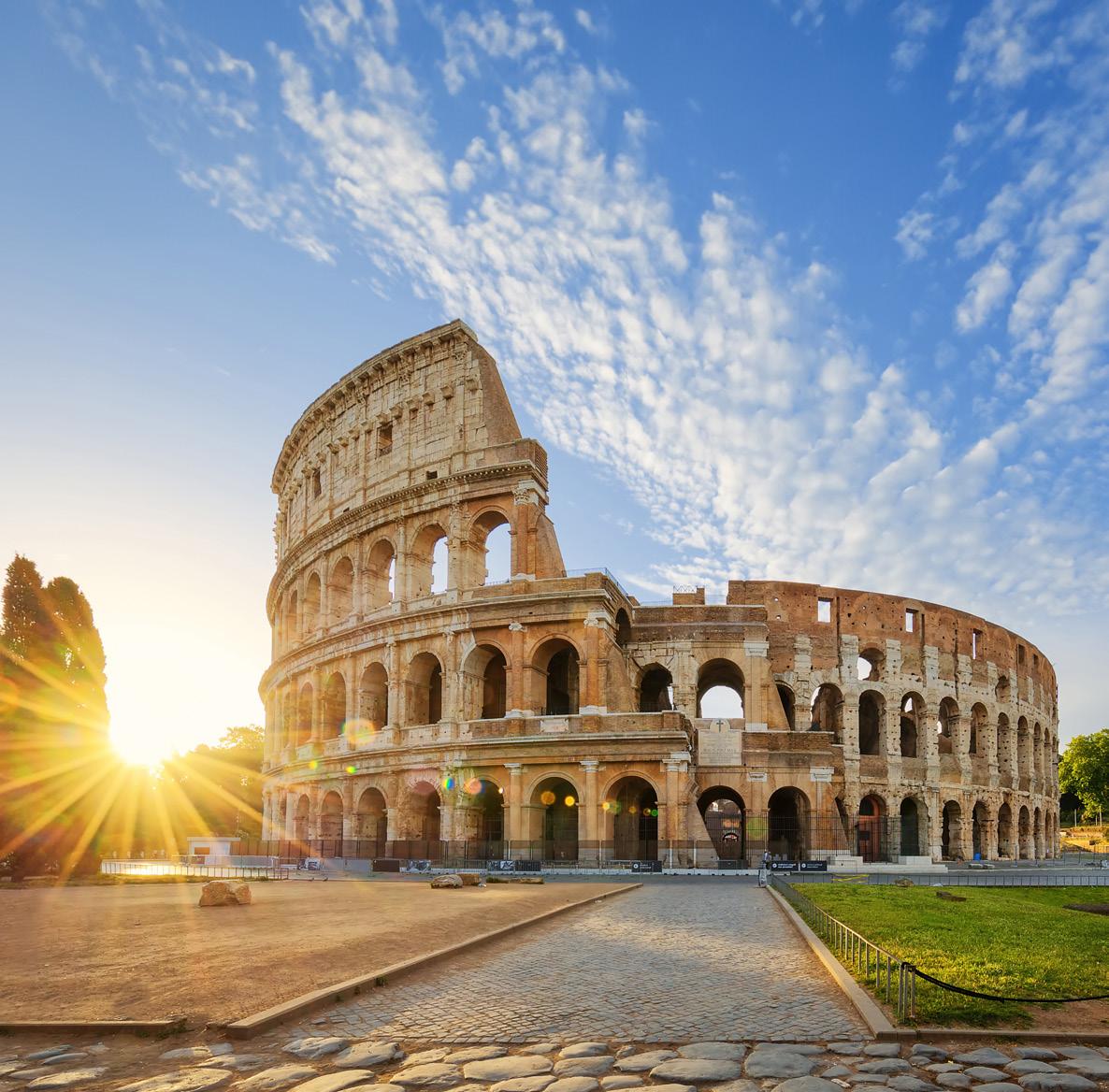
Rome is one of the most charismatic and engaging of the great cities of the world, her monuments an omnipresent testament to a past in which she controlled an Empire reaching from Scotland to Syria. Surprisingly, it is also an intimate city - the historic centre is small, and it is easy to understand based on the ancient layout. This tour is the perfect introduction to the ‘Eternal City’ in the company of archaeologist and historians who will bring to life the triumphs, tragedies and political intrigue that characterised the Roman Empire. We stay at the Albergo Santa Chiara in the very heart of the ancient city, situated directly behind the Pantheon, the perfect base for exploring Rome. It has been privately owned by the Corteggiani family since 1838 and consequently retains a feel of personal warmth and friendliness.
We fly to Rome and transfer to our hotel in the heart of the city.
This morning, we shall start at the Imperial Fora with the famous monument of Trajan’s Column and proceed from there through the Forum Romanun the political heart of the city and empire, a site of profound historical events such as the Gracchi riots and Caesar’s funeral. We continue to the Palatine
to visit the ruins of the Imperial palaces and in the afternoon we will explore the Colosseum, the iconic Flavian Amphitheatre – the largest of its type ever constructed. We end the day at the adjacent decorative Arch of Constantine Day Three | The Appian Way
Today we drive to the Appian Way and visit some of the villas of the senatorial aristocracy found there. Here we will see the vast suburban estate of the Quintili, so sumptuous that the emperor
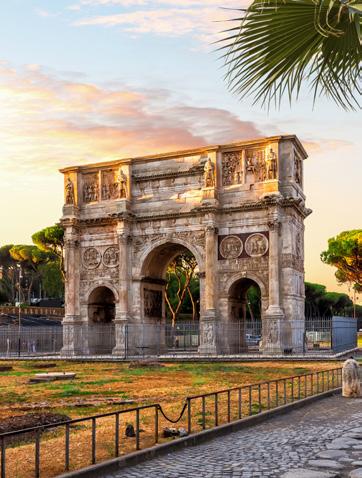
• Explore the underground ruins of Nero’s infamous Golden House, a revolution in architecture and luxurious design
• Walk along the Appian Way, visiting the Villa of the Quintili and the Circus of Maxentius
• Discover two important sites outside the city centre – the port of Ostia and Hadrian’s Palace at Tivoli

Commodus executed its owners and confiscated it. We proceed to the equally extensive Villa of the Emperor Maxentius built as a dynastic centre for his family. It includes the palace/villa, a chariot racing circus and large mausoleum. We will focus on the well-preserved Circus which includes starting gates. In the afternoon we will visit another huge imperial project, the Baths of Caracalla, capable of accommodating thousands at a time.
This morning we visit the legendary Golden House which the Emperor Nero built after the great fire of Rome as a rus in urbe, a countryside in the city, and as such included artificial lakes, fountains, vineyards. The megalomaniac building was eventually demolished by his successors and can now only be visited at certain times, in groups, where its ongoing restoration can be viewed. We continue to the extraordinary church of San Clemente to discover its underground surprises and the Domus Romane Del Celio, Roman houses which date from the 2nd century. Later we also visit the Parco Archeologico del Celio which opened recently. The museum
houses the remaining fragments of the Forma Urbis Romae, the giant marble map of ancient Rome engraved in the 3rd century during the reign of Emperor Septimius Severus. The last time the remains of the ancient map were seen by the public was a century ago when they were on display in the garden of the Palazzo dei Conservatori on the Capitoline Hill.
We leave the city and make the short drive to Tivoli where the Emperor Hadrian chose to build his palace. Hadrian’s Villa which sprawls across the rolling countryside at the foot of the hills below the town of Tivoli. Beginning around AD 117 Hadrian took a small family villa owned by his wife and added on a whole series of grand pavilions, many of them modelled after places he had seen on his travels around the empire. The complex ended up larger than most Roman cities. We visit the town this afternoon and pay a visit to the great 16th century Villa D’Este. Built by Cardinal Ippolito D’Este, the son of Lucrezia Borgia and a major figure in the church politics of the era.
This morning we take a walk through part of the Field of Mars, originally an open area lying just outside Rome’s earliest defences. It was used first as a training area and for meetings of public assemblies, then gradually monumentalised to provide a new zone of civic buildings to serve Rome’s growing population. Later we visit the Ara Pacis, an altar commissioned by the Roman Senate to honour the return of Augustus after his campaigns in Gaul. The afternoon is free to spend as you wish.
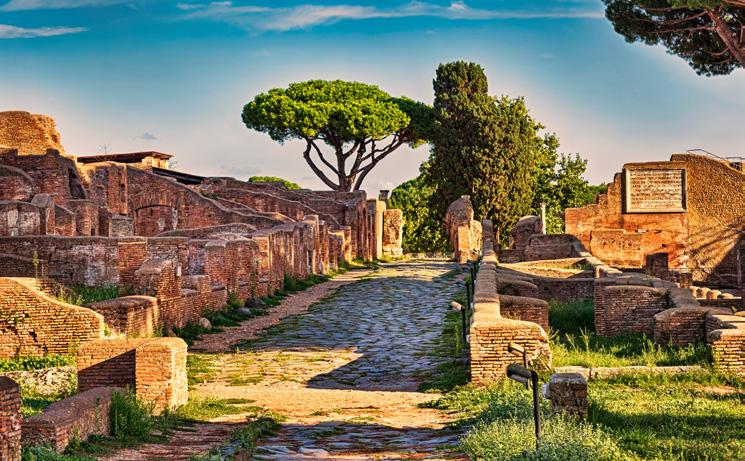
Dr Doru Bogdan
A researcher and lecturer at theUniversity of Alba Iulia in Romania, Doru is a specialist in Roman archaeology and has also supervised an array of fascinating excavations.

On our final day we shall leave Rome and travel to Ostia Antica, the ancient harbour city of Rome close to the mouth of the Tiber. Originally Rome’s first colony, it became a thriving port, handling the transhipment of goods and foodstuffs from sea going vessels to river barges in new harbours provided by Claudius and Trajan. Ostia still has the atmosphere of a seaport, with its docks, warehouses, apartment blocks, theatre and temples to a range of foreign and Roman deities. It is well-preserved, thanks to rising water levels in the late Roman period and lack of subsequent building, and it has been extensively excavated. From Ostia, we continue to the airport for our afternoon flight home.

Your comprehensive expert guided tour includes
• Expert Guide Lecturer & Professional Tour Manager
• Entries to all sites as per the itinerary
• Field notes
• All taxes & gratuities
Included travel
• Return flights from London & all local transport Accommodation
• Accommodation in the Albergo Santa Chiara Culinary inclusions
• 6 breakfasts, 4 lunches & 6 dinners
• Water with all meals, wine & tea or coffee with dinner
Dates & prices per person
Date
- 27th
Includes £200pp Special Offer discount if you book by 31st August 2024
For full details of this tour visit andantetravels.co.uk/arme
8 DAYS FROM £3,810pp

Activity Level
The last capital of the western Roman Empire, Ravenna was reconquered by Justinian and became the seat of an Exarchate, which also included Venice, whose connection to the east made it powerful. The result was an unparalleled collection of Byzantine art, with its unique domed architecture and shimmering mosaics.
Day One | London - Bologna - Ravenna
Today we fly to Bologna and make our way to Ravenna, where we will have an orientation walk, time permitting.
Day Two | Ravenna
Today we start our exploration of Ravenna with a series of incredible monuments, including the Arian Baptistery, constructed by the Ostrogoth Theodoric and the Neonian Baptistery, the 5th century baptistery converted from a Roman bath. We continue to the Ravenna Cathedral, and to the Archbishop’s Palace with its museum and private chapel of Saint Andrew. In the afternoon we visit the 4th century Church of San Giovanni Evangelista first founded by Galla Placidia in the
4th century and now containing mosaics depicting the 4th crusade which was so disastrous for Constantinople and the Byzantine empire.
Day Three | Ravenna
We start the day with a visit to the Basilica di Sant’ Apollinare Nuovo, Theodoric’s palatine chapel which was altered in the Byzantine period. A short walk away, we continue to the Basilica di San Francesco, the parish church of Dante who is buried there. In the afternoon we explore the late antique house, the Domus dei Tappeti di Pietra, replete with mosaics. We end the day at the National Museum, with its important collection of archaeological material from Ravenna and its environs. This evening we plan to have our exclusive

• Enjoy two exclusive private evening visits to the Byzantine Basilicas of San Vitale and San Marco
• An exclusive private visit to the Biblioteca Marciana, famed for its collection of Byzantine manuscripts
• Explore the unique Basilicas of Santa Maria Assunta in Torcello and Santa Maria e Donato in Murano
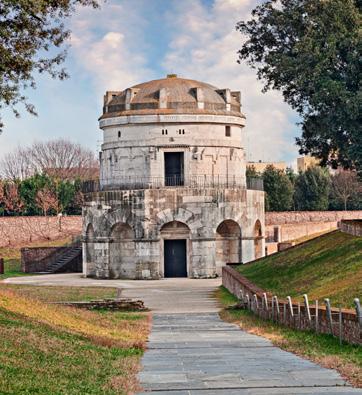
private visit to the Basilica di San Vitale, with its uniquely important Byzantine mosaics, as well as the late antique Mausoleum of Galla Placidia
We drive a little outside the city to visit the extraordinary Mausoleum of Theodoric, the Ostrogothic King who ruled from Ravenna after the collapse of the Western Roman Empire in the manner of a Roman emperor. After the Byzantine conquest of the city, Theodoric’s bones were removed from his tomb, leaving his wonderful porphyritic sarcophagus. This will be followed by an exploration of the archaeological site of Classe, Ravenna’s ancient port, which was hugely important for being the base of Rome’s fleet. In the afternoon, we continue to the Basilica di Sant’ Apollinare in Classe with its stunning apse depicting the Transfiguration.
Today we travel by coach to the lagoon city, Venice, which was immersed in Byzantine culture long after the Exarchate of Ravenna collapsed because of the special trading rights it was given by Constantinople, making it the gateway of the east. Venice also gave refuge to emigres escaping Constantinople after its fall in 1453. In the afternoon, we explore hidden gems in the extraordinary Piazza San Marco, dubbed the drawing room of Europe by Napoleon and dominated by the very Eastern looking Basilica di San Marco, a masterpiece of Byzantine architecture which underscores the city’s close ties to Constantinople. We will end our day at the Icon Museum
Today we explore the beginnings of Venice in the Northern Lagoon, starting with island of Torcello,
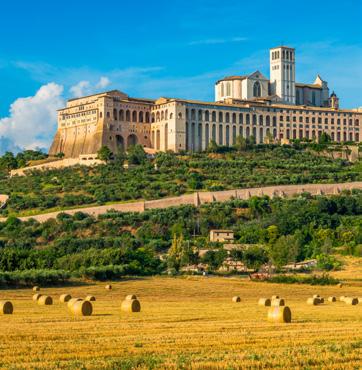
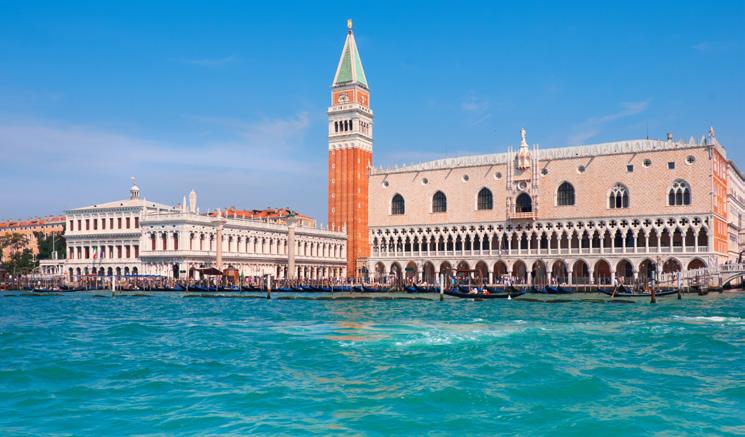
Tony O’Connor
A specialist in the Roman Empire, Tony has excavated widely across Britain, Europe and North Africa. He first led a tour for Andante over 10 years ago and he just gets better and better!

where the earliest settlers from the terra firma found their homes after escaping Hunnic raids in the 5th century. Here we see the Basilica di Santa Maria Assunta with its stunning Byzantine mosaics, notably the Last Judgement on the counter-façade. After lunch, we pay a short visit to Burano, the island famed for its lace and colourful houses, from whence some might also choose to venture to the adjacent island of Mazzorbo. We end the day with a visit to Murano, famed for its glass making and also for its Byzantine Basilica di Santa Maria e Donato
Today we visit the Greek Orthodox Chiesa di San Giorgio dei Greci erected by emigres from Constantinople. We continue to with an exclusive, private visit to the Biblioteca Marciana, established in the 15th century in order to house the Classical manuscripts collected by Cardinal Bessarion after the fall of Constantinople. After lunch, we have a private tour of the Secret Itineraries of the Palace followed by a guided tour of the Doge Palace. In the evening we have an exclusive private visit to the stupendous Basilica of San Marco whose mosaics and architecture were inspired by Byzantium.
Day Eight | Venice - London
This morning we make our way to Venice airport by water taxi, bidding farewell to the lagoon and its Byzantine heritage.
• Expert Guide Lecturer & Professional Tour Manager
• Entries to all sites as per the itinerary
• Field notes
• All taxes & gratuities
Included travel
• Return flights from London & all local transport Accommodation
• Accommodation in Ravenna & Venice Culinary inclusions
• 7 breakfasts, 6 lunches & 4 dinners
• Water with all meals, wine & tea or coffee with dinner
Dates & prices per person Date
Includes £250pp Special Offer discount if you book by 31st August 2024
For full details of this tour visit andantetravels.co.uk/arvv
8 DAYS FROM £3,260pp
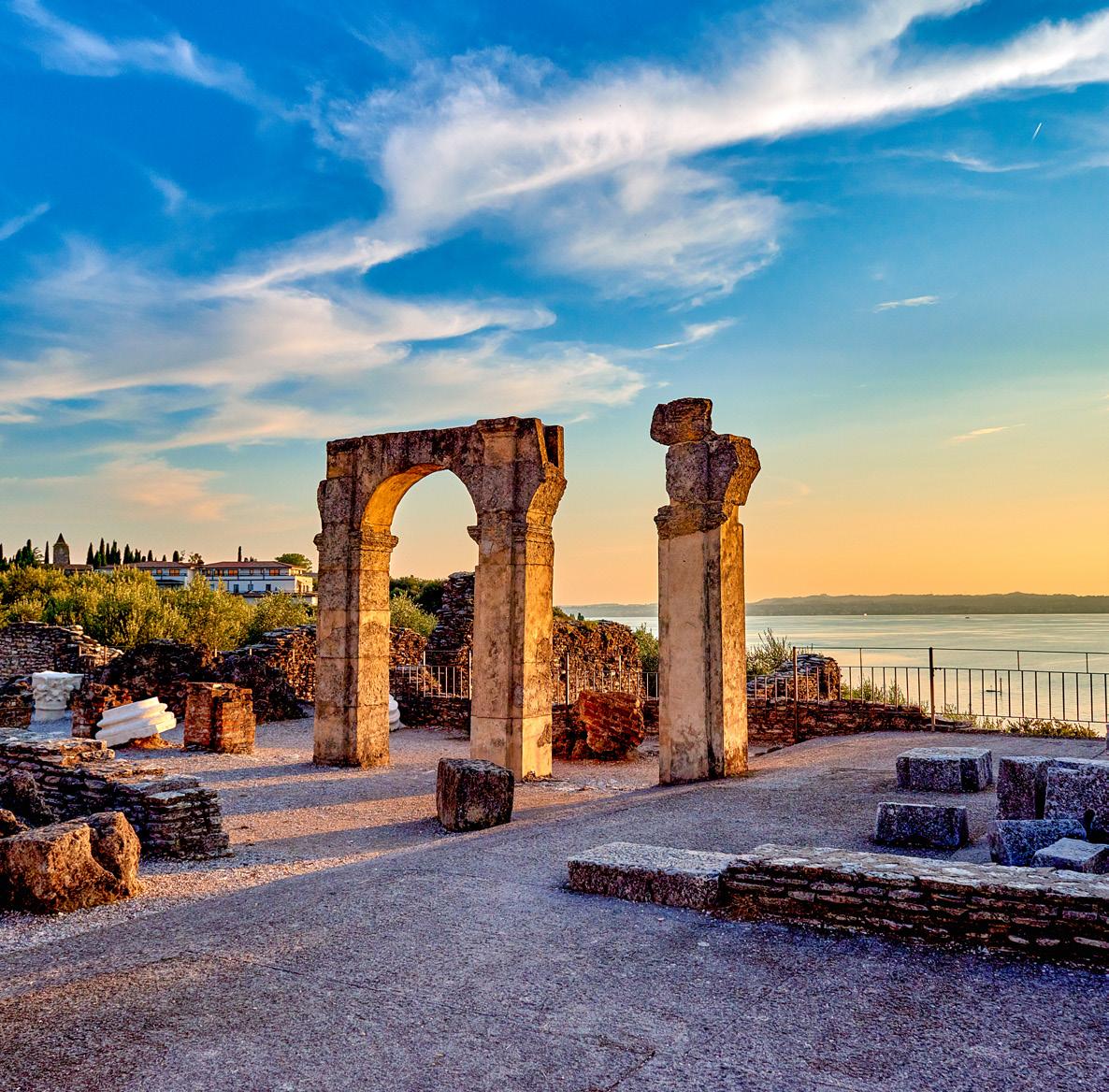
£0 SINGLE SUPPLEMENT PLACES AVAILABLE
“ I particularly enjoyed this tour because of the wide variety of sites visited, from Roman Villas to the Fumane Cave excavations and of course all the wonderful Medieval Architecture and art of the Veneto cities. The hotel was superb, with excellent staff in all departments.”
From Roman Province to Doge Republic, the Veneto has a long and illustrious history. We take a closer look at the intriguing area around Lake Garda and explore a truly unique mix of archaeology, art and architecture. From a prehistoric cave site adjacent to a 15th century ‘Roman’ villa, to a medieval monastery perched on the steps of an ancient Roman theatre, there is a great deal to unpick here. Visiting in the quieter months of spring and early autumn, we enjoy the undulating landscapes of vineyards and olive groves which surround the southern shores of Lake Garda and explore the pretty piazzas, medieval market places and tangled streets of Verona, Vicenza, Mantua and Padua. We’re sure this tour will hold your imagination and, to cap it all, we will be in the region of the Valpolicella wine
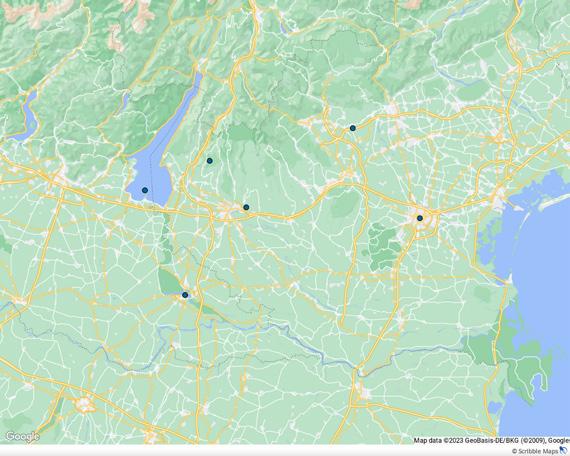
Day One | London - Verona - Sirmione
We arrive in Verona and transfer to our hotel in Sirmione, a picturesque medieval town perched on the tip of a narrow peninsula at the edge of Lake Garda.
Day Two | Verona
In the morning, we travel to the Desenzano Roman Villa, a once large and sumptuous property which enjoys stunning views of the lake. Here we discover
a rich group of coloured figurative mosaic floors depicting various scenes of cupids, maenads and satyrs; wild beasts and images of the four seasons. We return to Sirmione by ferry and, after lunch, we take the small train up the hill to the Villa Catullus, the largest and most complete Roman villa in northern Italy. The villa was constructed with long porticoes and terraces to maximise the views over the lake and at its centre was an extensive garden.
Day Three | Verona
Today is devoted to Verona, a city immortalised by Shakespeare and blessed with an abundance of Roman and medieval remains reflecting the evolution of this fortified town over its 2,000year history. We shall explore the core of the Roman town, its city gate, Porta Borsari, the Arco dei Gavi, the Roman theatre, and the magnificent amphitheatre, the third-largest in the Roman world, and we will admire many of its medieval structures. We will also pay a visit to the Archaeological
• Discover the extraordinary cave site of Fumane, one of the major prehistoric archaeological sites in Europe
• Enjoy the picture-perfect setting and cobalt blue waters of Lake Garda, Italy’s largest lake
• Explore the beautiful cities of Verona and Vicenza, Padua and Mantua and their plethora of UNESCO World Heritage Sites
Museum housed in an deconsecrated monastery which was literally built on top of the Roman theatre.
Day Four | Mantua
We spend our day today in Mantua, a gem of Italian art and architecture often overlooked by unenlightened visitors to the region. Once home to many literary figures of the late 1st century BCE Augustan age, it is also full of Renaissance wonders and contains the Palazzo Ducale, the largest residence in Italy after the Vatican. For 400 years this was the home of the Gonzaga family, the dukes of Mantua who ruled until 1707. We will explore this labyrinth which includes a castle, basilica, courtyards, sumptuous galleries and gardens.
Day Five | Fumane
We take a step further back into the past this morning when we visit the cave site of Fumane The cave contains traces of Neanderthal man and evidence of habitation by modern Homo sapiens, including sharpened flints, bones and decorations made from sea shells. The finds provide a crucial link in the history of human life on Earth as well as a first glimpse of the creative instinct that inspired Leonardo da Vinci and Michelangelo in a later age. Afterwards we visit nearby Villa della Torre, a beautiful villa by architect Giulio Romano, where we enjoy a wine-tasting and lunch before returning to Sirmione for some free time.
We spend our day in Vicenza, a UNESCO World Heritage Site and almost archetypical ideal of the Renaissance and Baroque era. Vicenza was a Roman settlement, which came under the sway of the Scaligeri family from Verona and was passed between Napoleon’s empire, Austria and Venice several times in its history. This jewel of a place is full of galleries, palaces and churches, and is noted for the works of the great architect Andrea Palladio. We will visit his amazing villa at La Rotunda. We will also visit Teatro Olimpico, one of only three Renaissance theatres remaining in existence.
Day
Our final visit of the tour is to Padua, which according to tradition going back at least to Virgil’s Aeneid, was founded in 1183 BCE by the Trojan prince, Antenor. This university town was home to some of the greatest philosophers, scientists, and artists in Western culture: Dante, Galileo, Giotto, Donatello and Copernicus, and the city is one of Europe’s great cultural and artistic destinations. Our visits will include the Scrovegni chapel, with its priceless frescoes by Giotto, the Civic museum, located in the cloister of the former Eremitani monastery, the Palazza del Bo and the Basilica of St. Anthony and baptistry.
Day
We return to the airport in Verona for our flight back to the UK.
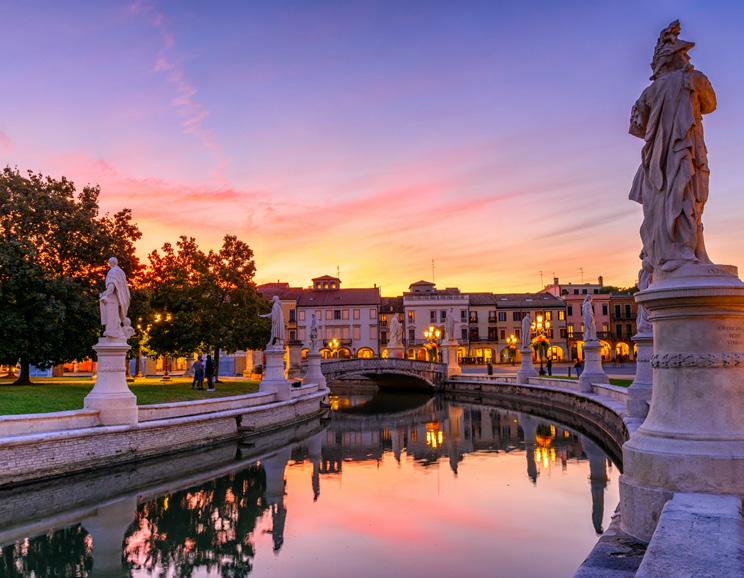
Tony O’Connor
A specialist in the Roman Empire, Tony has excavated widely across Britain, Europe and North Africa. He first led a tour for Andante over 10 years ago and he just gets better and better!


• Expert Guide Lecturer & Professional Tour Manager
• Entries to all sites as per the itinerary
• Field notes
• All taxes & gratuities
Included travel
• Return flights from London & all local transport Accommodation
• Accommodation in Sirmione Culinary inclusions
• 7 breakfasts, 6 lunches & 7 dinners
• Water with all meals, wine & tea or coffee with dinner
& prices per
Includes £200pp Special Offer discount if you book by 31st August 2024
8 DAYS FROM £2,840pp
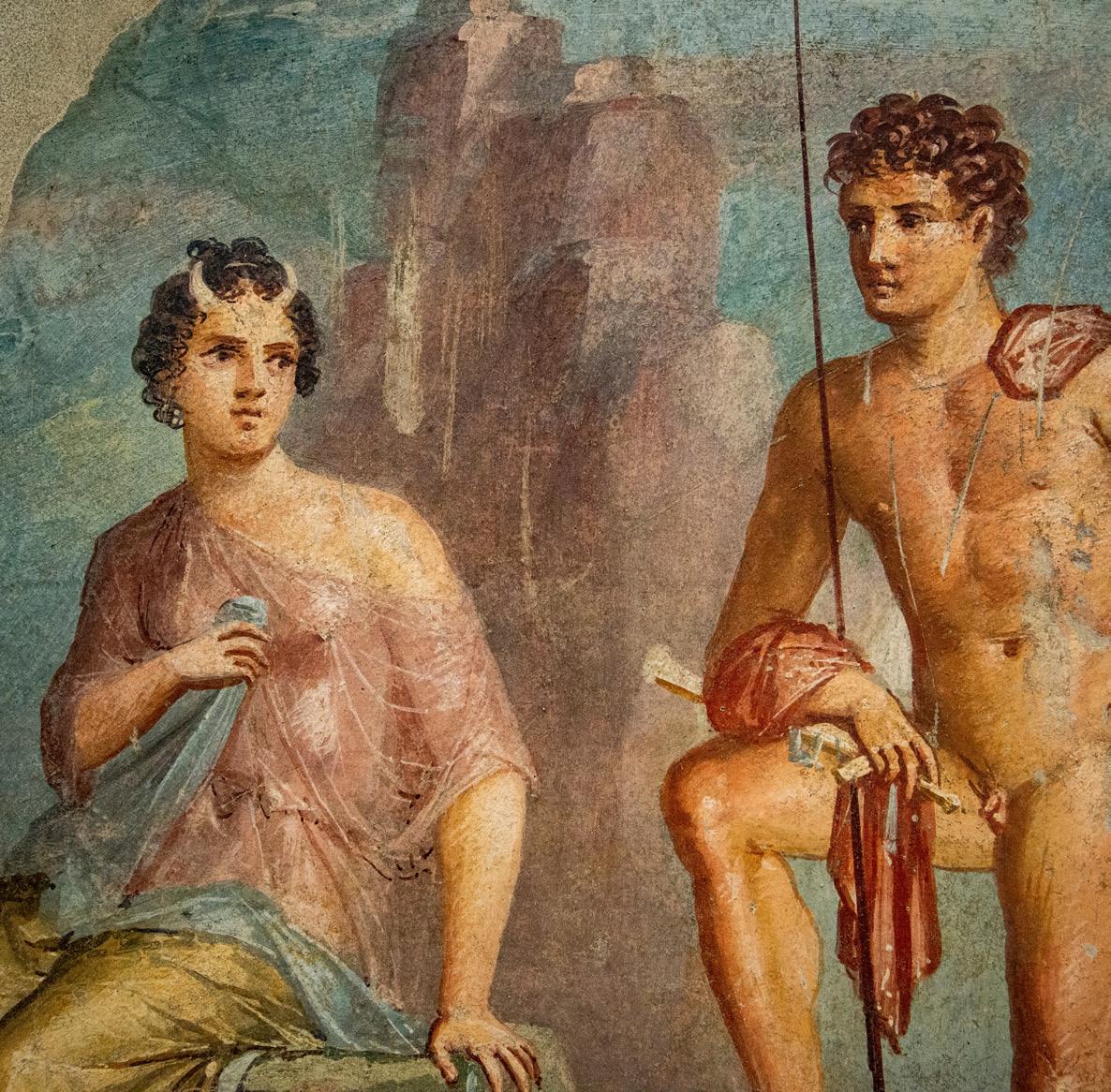
£0 SINGLE SUPPLEMENT PLACES AVAILABLE
Activity Level
The extraordinary Roman sites in the Bay of Naples have undergone an incredible regeneration in recent years. This beautiful stretch of coast, which was developed in the Roman era by elites and emperors in search of leisure, has witnessed exciting new archaeological activities, as well as an unprecedented number of newly opened sites. While much attention has been given to the wonderful new excavations of Pompeii, much less has been said about the opening of new sections of Herculaneum, the opening of Roman sites in Positano and Boscoreale, and the excavations taking place in Terzigno and Somma Vesuviana. This tour offers a fresh take of Romans in the Bay of Naples, taking into consideration these new discoveries and sites, and offering an up-to-date examination of this prosperous and beautiful part of the ancient world. There has never been a better time to visit the towns in the shadow of Vesuvius with the advantage of it being a less crowded time of year.
Day One | London - Naples - Cava de Tirreni
Today we fly from London to Naples and then we transfer to our hotel on arrival.
Two | Positano & Amalfi
This morning we drive to Positano, where we visit the Roman Villa and museum, with its dazzling frescoes. Discovered under the church of Santa Maria Assunta, this villa maritima, one of many
opulent coastal villas built along the Bay of Naples, may have been owned by the gladiator Posides who was a slave freed by the emperor Claudius. After a period of restoration, the villa has only recently been opened to the public. After lunch, we travel down the Amalfi Coast to Amalfi to explore the Cathedral of St. Andrew the 9th century and which is a mixture of different styles from its Arabic-Norman beginnings to
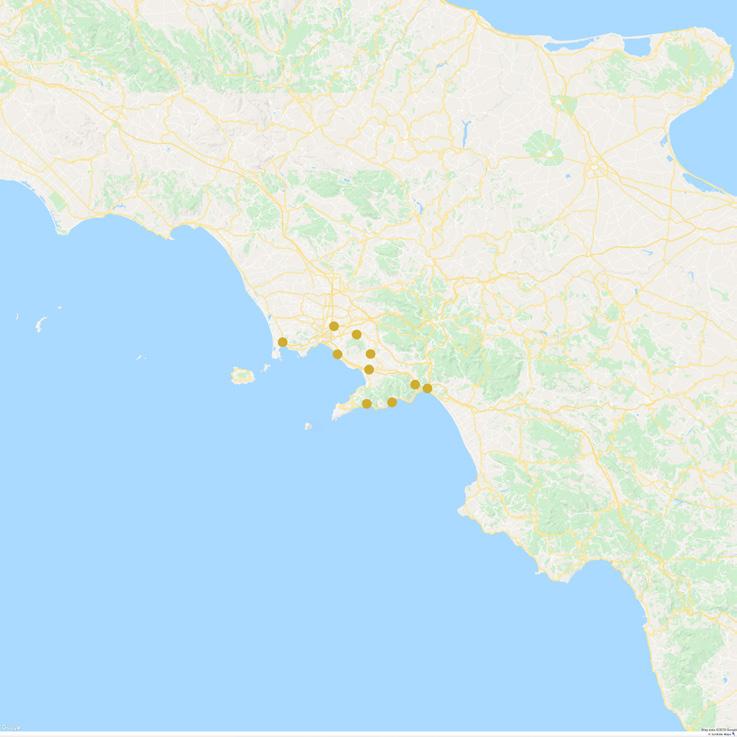
• Examine the newly opened Regio V in Pompeii
• Explore the newly opened Roman Villa at Positano, with its wonderful fresçoes
• Visit the newly opened Museum at Terzigno, which houses incredible remains of newly excavated villas
“ This was an excellent tour full of a variety of visits. Ample food and wine and thoroughly enjoyable company.”
We devote the entire day to Pompeii. No site compares in revealing the details of daily life in a Roman town. We visit some of the most wellpreserved buildings as well as an amphitheatre, theatre, forum, bath-houses, bars, and brothels. Fountains in the street are worn where countless people rested their hands to take a drink and Roman graffiti still marks the walls. Travelling via the best routes to avoid crowds, we visit several villas that are newly reopened to the public.
We start the day with a visit to the fabulous Museum of Archaeology in Naples, which exhibits the precious frescoes and mosaics discovered in the Vesuvian towns, including the Alexander Mosaic and the paintings of Sappho and the Pompeii riot. The western wing has recently re-opened following a decades long renovation project and showcases hundreds of previously stored finds from key sites in Campania. After lunch we explore two fascinating sites in Naples. Our first visit is to the church of Santa Chiara, burial place of the Angevin kings, and Bourbon dynasty where we admire the cloisters with their magnificent 18th century majolica tiles. Next, we visit San Lorenzo Maggiore founded in the late 13th century as a Franciscan church on the site of the site of the basilica (covered hall) of the Roman Forum.
We enjoy a morning of Roman waterworks, beginning with a visit to the amazing Piscina Mirabilis - a huge cistern which stored water for the fleet stationed in the harbour at Misenum. We continue to Baia, terraced into the side of an extinct volcanic crater, and developed entirely in the Roman period to cater to the desires of the super-rich who built enormous villas in order to take advantage of thermal springs. We visit the Archaeological Park where the imperial family built an enormous thermal and palatial complex. After lunch, we venture to the Flavian amphitheatre in Pozzuoli, one of the largest amphitheatres
in the ancient world. Here we will explore the best-preserved service rooms of any extant amphitheatre.
Today we visit Herculaneum, sealed by 23 metres of pyroclastic flow from the same eruption which buried Pompeii. The nature of the eruption has meant that organic materials have survived, making this a more poignant site than Pompeii: here we see a wonderfully preserved wine shop, the stunning House of the Stags with its pergola overlooking the sea and many fragments which attest to the everyday life in this upmarket city. There has never been a better time to visit the site, as two new museums have recently opened, as well as the House of the Bicentenary opened for the first time after decades. After an included lunch in Herculaneum, we visit Boscoreale where we visit the Villa Regina, discovered in the late 20th century while digging for the foundations of council housing. In contrast to the opulent villas we have seen on other days, this is a modest small holding which provides us with evidence of how ordinary people lived. We then head to the Museum of Archaeology at Terzigno, which houses precious remains and frescoes of 3 ancient farms destroyed by the AD 79 earthquake and excavated only recently.
Day Seven | Villa Sora & Somma Vesuviana
Today we go off-the-beaten-track to the villas of Stabiae, an exclusive setting for the very wealthiest and influential of the Roman elite. The vast Villa San Marco, with its swimming pool and bath complex, is one of the most opulent along this coast and still remains very impressive in its scale. We also visit the Villa Arianna, with its wonderful frescoes and fabulous views over the Bay of Naples. After lunch we visit the spectacular villa, often called Villa Poppaea, at Oplontis. This was only properly brought to light just 50 years ago and so the interior decoration is pristine, with so many excellent wall paintings. The authorities have also returned some of the artworks to the villa, so it is possible now to get a better idea of the quality of the sculptures that decorated this very high-ranking property.
Day Eight | Cava de Tirreni - Naples - London
We end our tour with one final private visit to the extraordinary archives of the Monastery of the Most Holy Trinity at Cava de Tirreni, which contains 15,000 parchments dating as early as the 8th century. When then head to the airport to catch our flight back to London.
John Shepherd
Winner of the Wanderlust World Guide Award - History & Culture 2023, John has worked extensively in the field in Europe as an archaeologist, including France, Italy and Bulgaria. Join John on our 3rd March departure.
Tony Wilmott


Senior Archaeologist with Historic England, Tony has directed many excavations, and published several books and many articles in archaeological journals. He specializes in the Roman periods, with a particular interest in the Roman military. Join Tony on our 31st March departure.
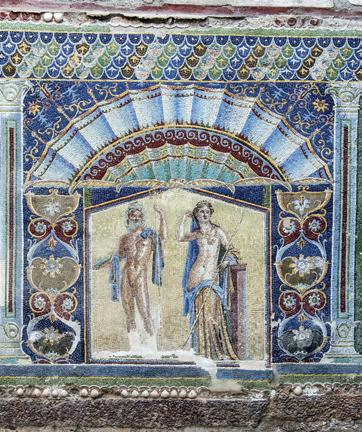
•
•
•
•
•
•
•
•
• Accommodation in the Hotel Scapolatiello or
•
• similar
•
•
•
Culinary inclusions
Culinary inclusions
• 7 breakfasts, 5
•
Dates
Includes £150pp
A short break to this ancient capital, unimpeded by the usual crowds
4 DAYS FROM £1,820pp
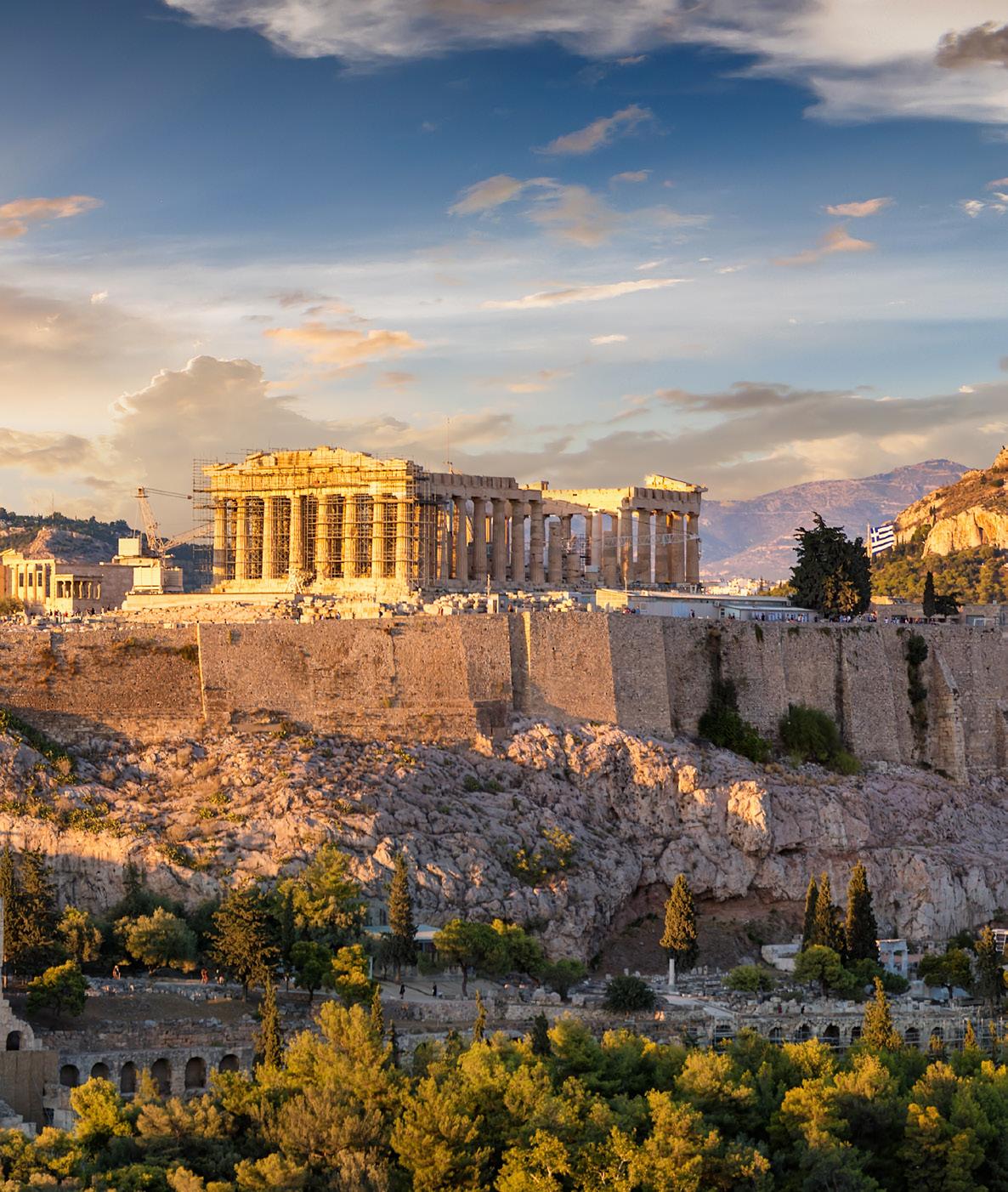
Activity Level
Enjoy an informed and in-depth visit to the ancient capital of Athens, unimpeded by the usual crowds. In the winter, the city belongs to the locals, the queues and crowds for the Parthenon melt away, there is space to gaze at its museum treasures and the dusty paths through the Agora grow greenery once again
We’ll visit classic Athens ruins, with sites including the Parthenon, two worldclass museums, and other fascinating archaeological sites. Wrap up warm and join us as we explore the city where democracy, architecture, classical art and literature both germinated and flourished.
“ The whole tour was excellent. Lovely hotel as were the cafes and restaurants. A great introduction to the history of Greece.”
• Ascend the Acropolis to the Parthenon, the universal symbol of the classical world and the quintessential classical ruin
• Explore two fabulous world-class museums, housing between them some of the greatest collections of antiquities in the world
• Soak up the atmosphere of ancient Athens, exploring the quieter corners and monuments which have survived here for 2,500 years
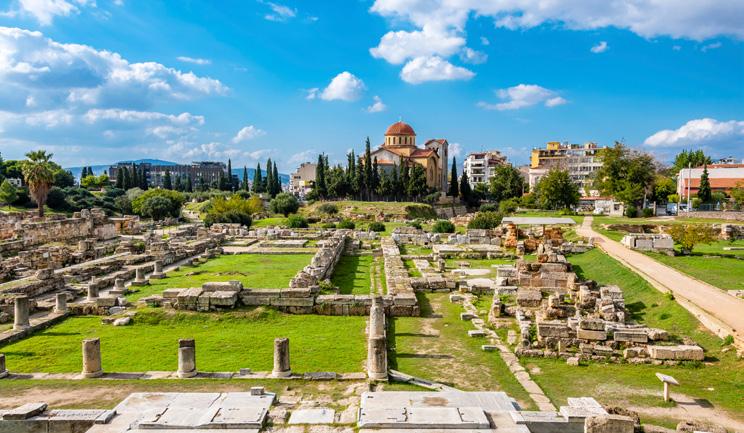
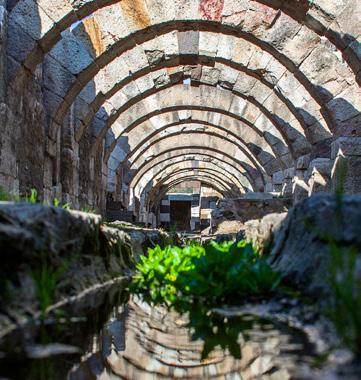
One | London - Athens
We fly from London to Athens and settle in to our hotel.
Our first full day will be dedicated to the Acropolis and its museum. We will walk through ancient Athens and then climb to the incomparable Acropolis, which still dominates the city with a complex of religious sanctuaries, most famous of which is the Parthenon – ‘Chamber of the Maiden’ built in the 5th century to house a colossal statue of Athena, patron goddess of the city. The views from here are stunning. After lunch in the Plaka, we visit the fabulous Acropolis Museum, which is consistently rated as one of the best museums in the world.

Dr Rita Roussos
A native Athenian, Rita taught archaeology and art history at the American University of Athens.

We continue our exploration of Athens, visiting its ancient economic centre, the Agora, where a wide range of goods were shipped in from the nearby port of Piraeus and members of the elected democracy assembled to discuss affairs of state. Next, we visit Kerameikos, named in ancient times after the hero Keramos, son of Dionysus and Ariadne, where an extensive cemetery was excavated during the 19th and early 20th centuries. After lunch we visit the National Museum of Athens. Now somewhat overlooked by visitors flocking to the Acropolis Museum, it is worth remembering that this older museum is still home to one of the greatest collections of antiquities in the world.
In the morning, we travel to Piraeus which once consisted of three separate harbours - Kantharos, Zea, and Munichia. All three harbours are still used today but since the sea level has risen two metres since antiquity many of the ancient installations of Piraeus are now underwater. Excavations still continue, however, and notable finds have included several bronze statues, perhaps the most famous being of Apollo now in the Piraeus Archaeological Museum. Later today we board our return flight home to London.
Your comprehensive expert guided tour includes
• Expert Guide Lecturer & Professional Tour Manager
• Entries to all sites as per the itinerary
• Field notes
• All taxes & gratuities
Included travel
• Return flights from London & all local transport Accommodation
• Accommodation in the Herodian Hotel or similar Culinary inclusions
• 3 breakfasts, 2 lunches & 3 dinners
• Water with all meals, wine & tea or coffee with dinner
Dates & prices per person
Includes £50pp Special Offer discount if you book by 31st August
For full details of this tour visit andantetravels.co.uk/asat
7 DAYS FROM £3,595pp
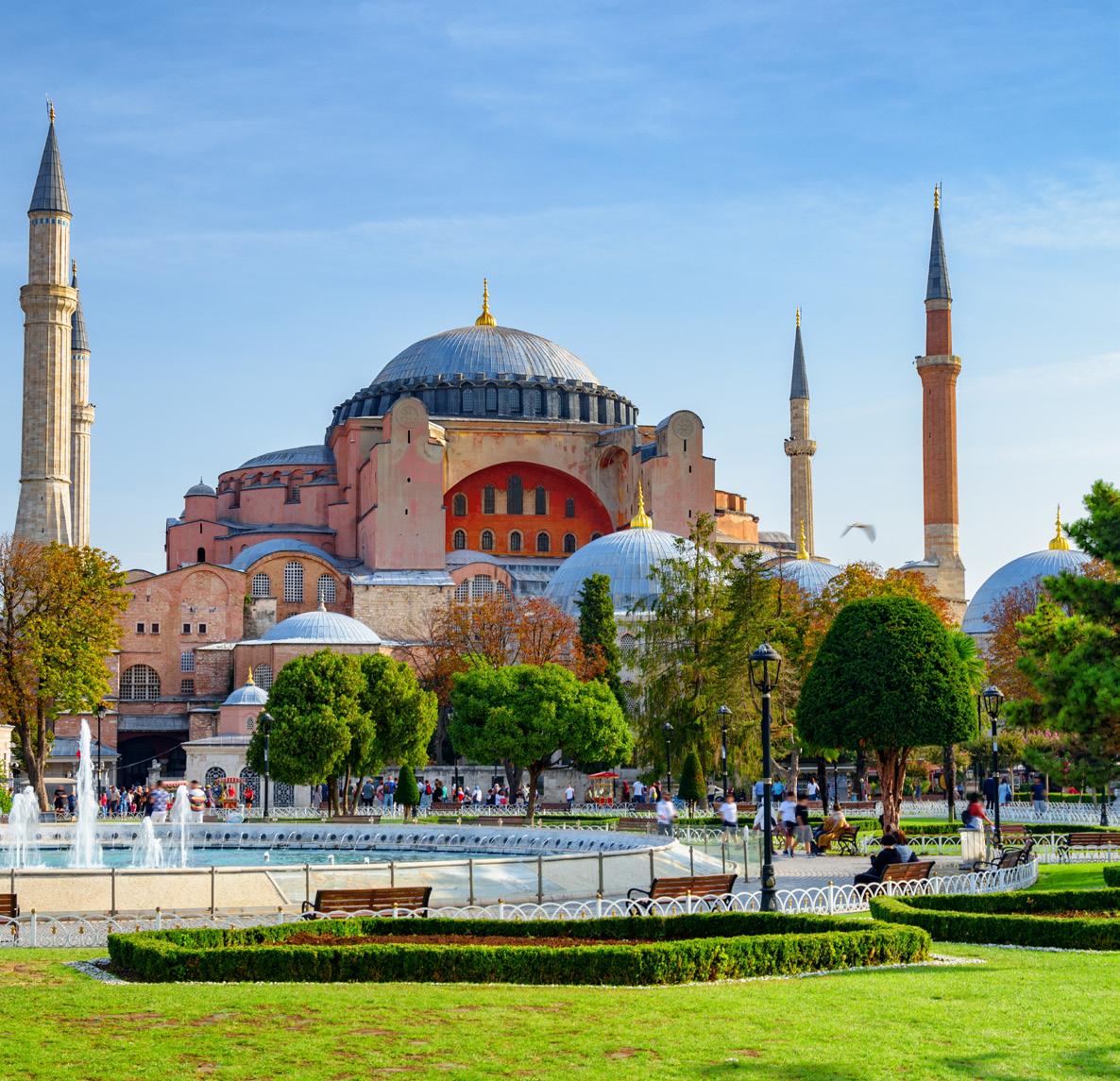
Founded as Byzantium, famed as Constantinople, the city we know today as Istanbul straddles two continents and has played a pivotal role in world history. It is one of the most delightful and complex cities in the world. We explore the major monuments of the city centre but also take a boat ride on the Bosphorus, which affords views back over the unmistakable skyline of the city broken by hundreds of slender soaring minarets. The bustle, good natured hustle, scents and sounds of this city are unforgettable.
We are based in Sultanahmet, the site of old Constantinople. This historic and compact area is largely pedestrianised and is home to four of the city’s major historic monuments: the Hagia Sophia, Topkapi Palace, Blue Mosque and Grand Bazaar. Guide Lecturer Terry Richardson, author of the Rough Guide to the city, provides invaluable ‘insider’ knowledge of a city he knows and loves so well and travelling out of season, we enjoy this wonderful city when the summer crowds have departed.
Day One | London - Istanbul
We fly to Istanbul and transfer to our hotel in the historic district of Sultanhamet.
Day Two | Hagia Sophia & Spice Bazaar
This morning we start with the great basilica of Hagia Sophia. Built by Justinian in the early 6th century, converted into a Mosque in the 15th century, secularised as a Museum in the 20th
and repurposed as a Mosque in the 21st, this architectural marvel is not just a place of worship but a long enduring symbol of the city. We continue to the Yerebatan Sarayi, a cavernous Byzantine underground water cistern which once supplied the imperial palaces until they fell into ruin, and it was forgotten. Now, we can walk on wooden walkways above the water and admire its remarkable engineering. After lunch we explore
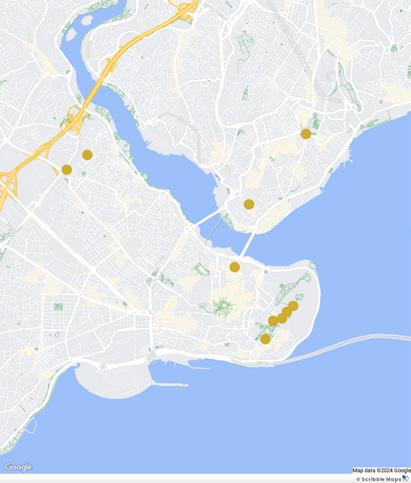
the Sulemaniye mosque complex built by the architect Sinan for the Sultan in the 16th century. The mosque and its courtyard are at the centre of a complex which comprised a madrasa, alms-houses, infirmaries, caravanserais, a medical school, baths, a hospital, and shops. We end the day with a visit to the Spice Bazaar, located at the southern end of the Galata Bridge and next to the New Mosque, Yeni Cami.
• Explore the vast and rambling Topkapi Palace, a palace like none you will ever have seen
• Enjoy an afternoon on the waters of the Bosphorus to put the city in its geographical context
• Soak up stunning panoramic views from the viewing platform of the Galata Tower
• Discover the history behind the unforgettable skyline of graceful minarets and monuments

Today we begin at Taksim Square in the ‘European Quarter’ of the city. From here we walk down Istiklal Caddesi, formerly known as the Grand Rue de Pera during the Ottoman period when it attracted an intellectual crowd and became the place to stroll for French Levantines. We visit the superb Pera Museum which houses a private collection of historical artefacts and paintings from the Ottoman period and then continue after lunch to Galalta. Here we see the 61-metre-high Galata Tower, which once formed part of the fortifications of the walls protecting the Genoese colony. A lift does most of the work, but there’s still a couple of staircases climbs to reach the viewing platform, which allows a stunning 360-degree panorama of the city. We will also visit the Galata Mevlevi Museum, the beautifully preserved semahane or dance hall, where adherents of the faith once performed a ritual, rotational dance (hence the name we in the West use for the Mevlevi, Whirling Dervishes), forms the centre piece of the museum. We conclude the day with a stroll across the architecturally undistinguished but ever fascinating Galata Bridge, lined with hopeful anglers and cheap and cheerful restaurant-bars, which links Europeanised Pera/Galata with the old city centred on Sultanahmet.
Four | Walls of Theodosius & Palace of Porphyrogenitus
Our first visit today is to the Walls of Theodosius constructed to protect the new imperial capital by Constantine, expanded and reinforced by Theodosius in the 5th century. These walls protected the city for over a 1000 years and once formed a virtually impregnable barrier. Here we visit the Ottoman Turkish fortification of Yedikule and the Golden Gate and the Church of
Zoodochus Pege. In the afternoon we continue to the Panorama 1453 Museum. Painted right around the drum and shallow dome is a vivid scene showing Sultan Mehmet II’s troops besieging the walls of Constantinople. It may be popular history, but it does help to bring the momentous events of the spring of 1453 into vivid focus. Our last visit of the day is to the Byzantine Palace of Porphyrogenitus. Not much remains of this once magnificent building but it gives some idea of what the emperor’s residence might have looked like in late Byzantine times.
Five | Hagia Eirene & Bosphorus
This morning we visit the Hagia Eirene originally built in the 4th century and reconstructed in the 8th after a catastrophic fire. Used as an arsenal until the 19th century, it is one of the few churches in Istanbul that have not been converted into a mosque and is now a museum and a concert hall. We continue to the excellent Istanbul Archaeological Museum built by the Sultans to house their collections from across the Ottoman Empire. This afternoon we take a private boat trip on the Bosphorus from Eminonou Pier up the majestic waterway that separates Europe from Asia and links the Black Sea ports to the Mediterranean.
Six | Topkapi Palace & Blue Mosque
Today we explore the famous Topkapi Palace, the rambling palace complex of the Ottoman sultans until they moved in the 19th century to a Frenchstyle building on the Bosphorus water front. Now a Museum, Topkapi is a veritable treasure house of architecture and applied arts, a palace like none you will ever have seen. After lunch we will stroll in what was the central spina of the Hippodrome. Its soaring seating accommodated tens of thousands of spectators, or, on occasions, angry citizens taking noisy part in political meetings. Whilst in this part
Terry Richardson
Terry Richardson has a university background in ancient history and classical civilisation. Terry is the author of numerous renowned guide books on the country, including Rough Guide Istanbul, Pocket Rough Guide Istanbul and Rough Guide Turkey.

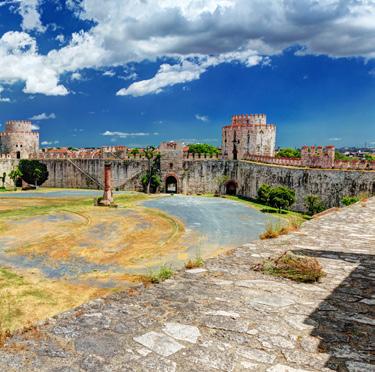
of the city, we will also visit the Blue Mosque with its high dome and semi-domes, multiple minarets and beautiful interior richly blue with the finest tiles from imperial tile-makers of the time. Our site visits conclude at the Church of Saints Sergius and Bacchus, Roman soldiers who were martyred under Emperor Maximian around 300.
Day Seven | Istanbul - London
We return to Istanbul airport for our flight home to London.
• Expert Guide Lecturer & Professional Tour Manager
• Entries to all sites as per the itinerary
• Field notes
• All taxes & gratuities
Included travel
• Return flights from London & all local transport Accommodation
• Accommodation in the Hotel Eresin Sultanhamet, Istanbul
Culinary inclusions
• 6 breakfasts, 5 lunch & 6 dinners
• Water with all meals, tea or coffee with dinner
Dates & prices per person
Date Twin/Dbl Share SS
17th - 23rd Mar £3,795 £3,595 £690
Includes £200pp Special Offer discount if you book by 31st August 2024
For full details of this tour visit andantetravels.co.uk/aboi
Spend two days in the evocative rock-cut city of Petra
10 DAYS FROM £4,470pp
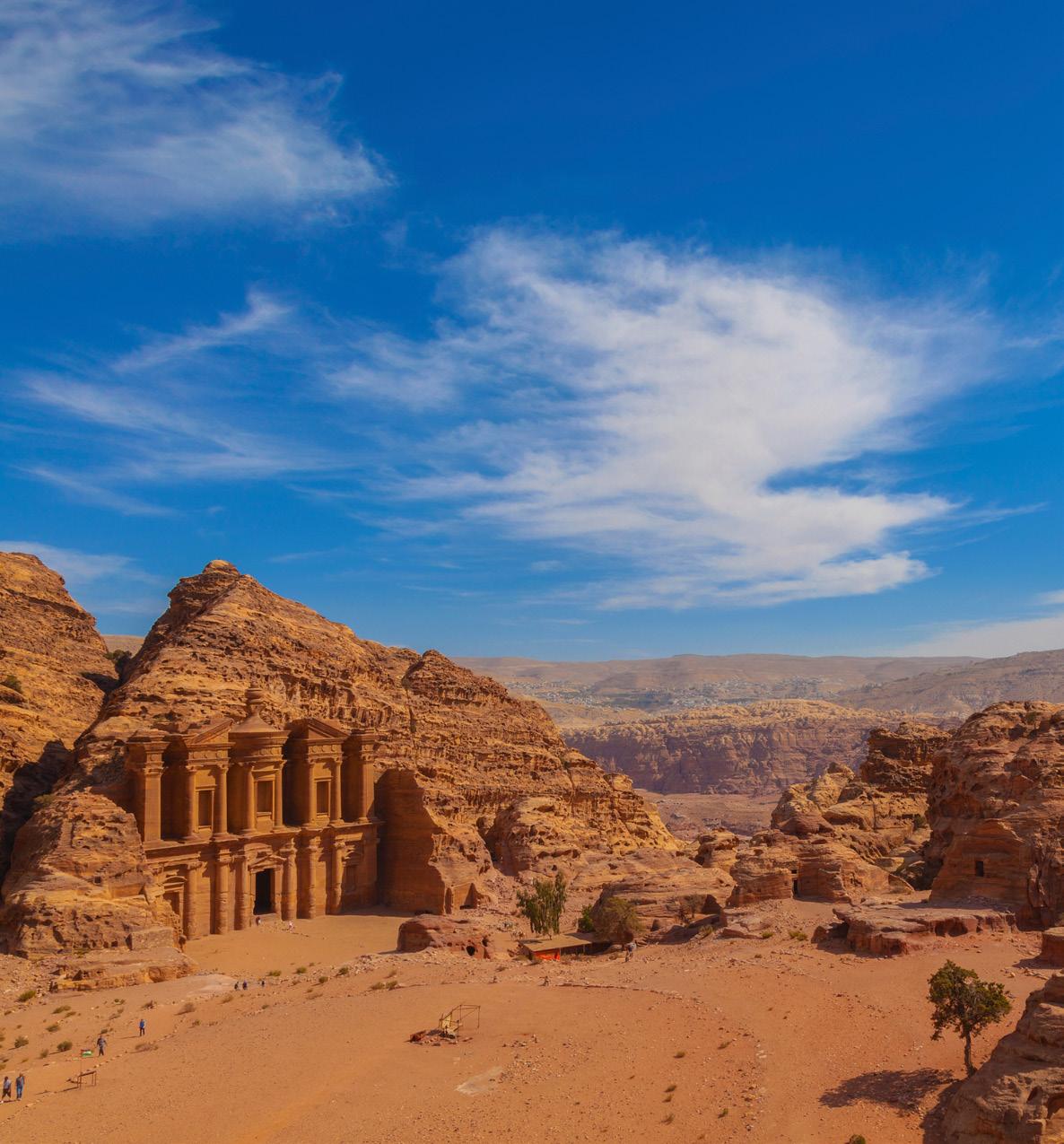
“ I enjoyed every minute, I felt safe and well looked after, I learnt and saw so much.”
Nothing can prepare you for Petra - the scale, the colours and the grandeur. Lively, cosmopolitan and rich, with goods from every corner of the world, ancient Petra was an extraordinary city. Its streets were swathed in a fusion of Nabataean and Classical architecture - elaborate tombs, colonnaded streets and temples carved into the rose-red rock.
Day One | London - Amman
We fly to Amman from London and travel to our hotel.
Two | Wadi Seer - Dead Sea - Amman
After a leisurely start, we head to the valley of Wadi Seer. Here we find the remains of Qasr-al-Abd, a well-preserved Hasmonean and rare Hellenistic period Palace. Hyrcanus of Jerusalem built the palace around 200 BC as part of a much larger estate, that is now covered by the village of Iraq al-
Emir. We then spend time both at and in the Dead Sea. The lowest place on earth is also the deepest hyper-saline lake in the world, over nine times saltier than the ocean. This salinity has created a harsh environment so it is unsuitable for any plants of wildlife, hence its name. It is however, a unique experience to be able to ‘float’ on the Dead Sea, so we make the most of this opportunity. After our time here, we return to Amman.

• Admire the almost lunar-like desert scenery of Wadi Rum
• Discover the mighty crusader castle at Kerak, built in the 12th century
• Visit Jerash, the best preserved (and Jordan’s largest) Roman town in the east, a site that is home to the Oval Plaza and the Corinthian columns of the Temple of Artemis
We explore two Roman Decapolis cities today as our adventure continues. We start off at the ancient city of Gadara (known today as Umm Qais), which offers views over the Golan Heights and Sea of Galilee. After lunch we continue to Jerash (ancient Gerasa) for the afternoon, which is set in the pine valleys of the biblical land of Gilead, and is one of the best-preserved Roman cities in the east. The architecture is particularly fine, and includes the impressive 2nd century Hadrian’s Arch, the Corinthian columns of the Temple of Artemis and the Oval Plaza - framed by a magnificent colonnade - a unique feature of the Forum.
The morning is spent in Jordan’s modern capital Amman. Here we visit the Archaeological Museum and the citadel. The museum is home to artefacts from archaeological sites from across the country, including the Dead Sea bronze scroll written in Aramaic characters. The citadel is one of the oldest continuously inhabited places in the world, and we visit the ruins of the Roman Temple of Hercules and the palace of the Omayyad Caliphs. Before lunch we visit the Memorial Church at Mount Nebo. In the afternoon, we make a short drive to the early Byzantine Church of St. George in Madaba, where we view the amazing 6th century mosaic map of the Holy Land depicting biblical sites of the Middle East from Egypt to Palestine. Afterwards, we spend a little time in the Madaba Archaeological Park before heading back to our hotel.
Today we head into the eastern desert to explore the dramatic basalt city at Umm al-Jimal, even the doors are made of huge black slabs and some of them still operate! After lunch we travel on to the desert castles, Qasr Azraq, Amra and al-Kharanah,
with far-reaching views over the surrounding landscape. Jordan’s desert castles were so called due to their imposing stature, but they served mainly as agriculture and trade centres, and caravan stations.
We visit the church and spectacular mosaics at Umm al-Rasas. A Roman and Byzantine site, the mosaics of the churches have fine depictions of the principal cities of the region. Before lunch, we have a stop at a viewpoint at Wadi Mujib. On next to the mighty crusader castle of Kerak, one of the largest in the Levantine region. Overlooking the Dead Sea, it was built in 1132 as the first line of defence for the Crusader kingdom of Jerusalem. Its position gave control of important trade routes between Damascus, Egypt and Mecca, and of the region’s Bedouin herders.
Today is the first of two full days in Petra, and with the archaeological park spread across 200 square kilometres, we will easily fill our time spent here as there is much to explore. Located among mountains and rugged desert canyons, this ancient capital of the Nabatean Arabs is carved directly into a mixture of sandstone cliff face, its colours a mixture of red, white and pink hence it is also known as the “Rose City”. We walk into the site each day, both for the sense of discovery, and to experience the famous entrance to the ravine site, the Siq. As we wander along the colonnaded streets, we take in some of the ancient city’s most significant structures, such as the world-renowned “Treasury” (Al-Khazneh), a temple over 40 metres in height with a truly impressive ornate façade. The Nabateans, though essential nomadic, developed a sophisticated water technology, the remains of which we will also see here during our extensive visit. Led by our expert guide, there are optional climbs on both days to Nabatean ‘Monastery’ and the ‘High Place’.
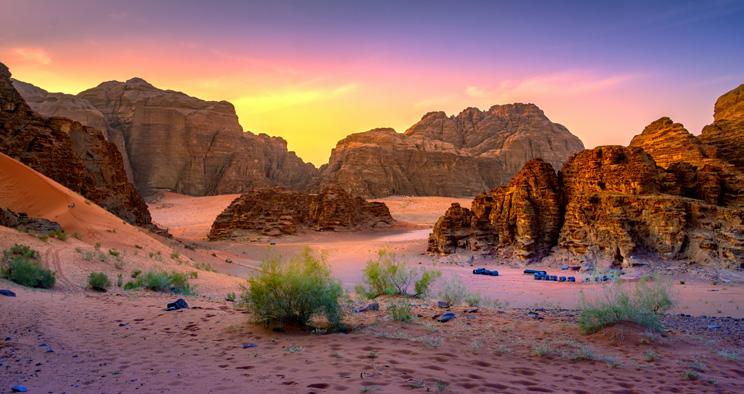
Nick Jackson
A

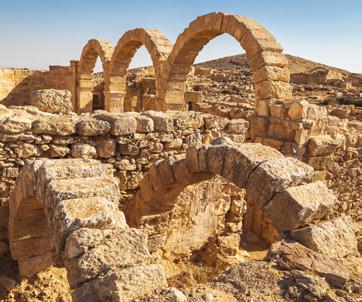
This morning we will visit the Neolithic site of Beidha, where 8th millennium BC houses can still be seen, and the painted tomb at “Little Petra” (Siq al-Bahrid). Thought to have been an important suburb of Petra, the site includes temples, tombs, water channels and cisterns carved out of rock. We drive to Wadi Rum, home of the largest Roman copper mine in the empire. Here we take 4x4s through spectacular scenery, made famous by the filming of “Lawrence of Arabia”. There are also several rock art sites to be explored here. Afterwards, we head back to Amman for a farewell group dinner.
Our tour ends in Amman and we catch our included return flights back to London.
Your comprehensive expert guided tour includes
11 DAYS FROM £6,595pp
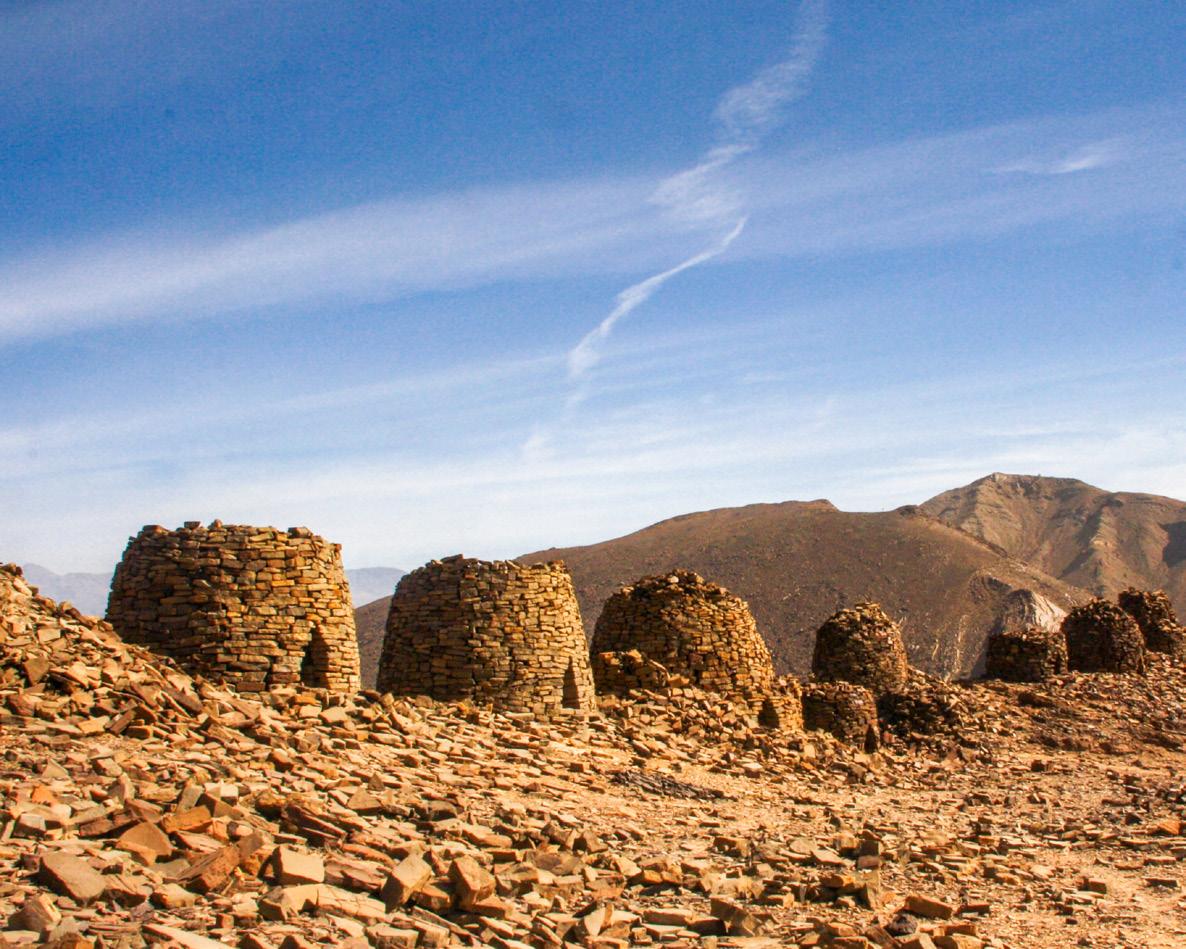
Oman has been a crossroads of commerce for millennia. Traders came here from Mesopotamia for copper, Petra’s Nabateans for incense; Greek and Roman merchants rode the monsoon winds that blew them to India and Arab seafarers used it as a base for trade to East Africa. Always there was the to and fro of caravans across the sands of connecting Arabia with the Mediterranean, through trading hubs such as the legendary lost city of Ubar, swallowed by the sands of the Empty Quarter around 300 AD. Its archaeology has only recently begun to be understood but is now known to include a rich prehistory of Bronze Age tombs and Iron Age fortresses as well as Classical trading settlements, mosques and emporia of the Islamic Age.
Travelling from the mountains of Muscat to the beaches of Salalah, we explore the hub of Classical Arabia Felix, the great incense city of Sumhuram with a special drive out into the Empty Quarter to take us to the site of the lost city of Ubar, entrepot of the Frankincense trade.
We fly from London on an overnight flight to Muscat.
We spend the day in Muscat, an ancient trading city, noted by the geographer Ptolemy in the 2nd century and at times part of the Sassanid Persian Empire. The city was centre of trade and power on the Gulf of Oman and Indian Oceans. The Portuguese held it for a century but from the 17th century it was one of the hubs of the Omani Empire and its rulers ultimately overcame the power of the Imam princes of Nizwa to rule all Oman. Visits in the morning include the Grand Mosque and time to wander through the labyrinthine alleyways Muttrah Souq. In the afternoon we take a short drive to the Al Alam
Palace followed by a visit to the National Museum of the Sultanate of Oman which showcases the nation’s heritage from the earliest human settlement through to the present day.
Day Three | Muscat - Nizwa
Today we travel in 4x4s through date palm orchards to Al Hazm fort Al Ayn and the UNESCO Site of Bat where we discover the extraordinary Bronze Age beehive tombs. The tombs are part of a major copper mining settlement of the Umm-an Nar culture of the 3rd millennium BC. This region of Oman was a vital centre of early metallurgy, the ore being exported as far as Mesopotamia and smelting taking place regionally. The distinctive 'beehive' dry stone tombs form an enormous necropolis. We continue to the historic walled town of Nizwa for the night.

Day Four | Al Hamra, Wadi Ghul, Wadi Nakhar & Misfah
We drive to the atmospheric village of Al Hamra, nestled in the foothills of the Jabel Ahkdar. Its old multi-storied mud houses are surrounded by a vast expanse of lush green date plantations. From here we continue to Wadi Ghul, home of the traditional weavers of Oman, and then to Wadi Nakhr, Oman’s deepest canyon to see rock art and Bronze Age tombs. Our next stop is Misfah, a lovely village with
• Follow in the footsteps of the ancient caravans as we explore rock art, Bronze and Iron Age, classical era and Islamic sites
• Explore the striking Bronze Age tombs at Bat, a UNESCO World Heritage site
• Enjoy beautiful contrasting landscapes from the red gold dunes of the Wahabi desert to craggy mountains and glittering blue Arabian Sea
• Discover the once lost city of Ubar in the sands of the Empty Quarter

stone houses precariously clinging to the side of the mountain cliff where we enjoy a picnic lunch. Afterwards we’ll explore the Falaj irrigation system Day Five | Wadi Tanuf, Nizwa, Jabrin & Salut Today we make our way to Wadi Tanuf, set against the backdrop of the Al Hajar mountains. Here we’ll enjoy a short walk to see rock art and Hafit (Early Bronze Age) tombs. Afterwards we explore Nizwa, capital of the ancient Imamate of Oman, an ancient centre of trade in the pre-desert and the birthplace of Islam. We visit the famous Round Tower Fort, built in the seventeenth century, and its souq, renowned for its intricately hand-carved khanjars (daggers) and ornamental silver jewellery. After lunch we drive to Jabrin; more of a fortified palace than a fort, it was built in the 17th century by Bil’arub bin Sultan, one of the Imam princes of Nizwa as a retreat and became a centre of Islamic scholarship and learning. We conclude out day in Salut, near Bisyah an archaeological site home to an ancient, fortified collection of ruins and fortifications, which offer rare evidence of the development civilizations in the Arabic peninsula in the Bronze and Iron ages.
Day Six | Nizwa – Lizq - Wahiba Sands
The archaeological site of Lizq in Ash Sharqiyah is our first visit today. Discovered in 1979 the hill fort here has pottery similar to Early Iron Age sites. We continue to Wahiba Sands, a vast desert region inhabited by the Bani Wahiba, Al-Harthy and AlHinawy tribes. The northern part of the Wahiba is dominated by huge parallel layered rusty coloured dunes. We shall spend the night at a desert camp where free of light pollution, we admire the star studded Arabian night sky.
This morning, we leave the desert and drive to Muscat where we will catch our flight to Salalah, the historic centre of Dhofar and source of the frankincense trade which flourished in this region for centuries. Highly valued for its aromatic properties, frankincense was one of the most important commodities in the ancient and medieval world and its extraction was responsible for the construction of cities, forts, and irrigation systems in the harsh desert environment.
Day Eight | Sumhuram, Wadi Darbat & Mirbat
Today starts at Khor Rori Creek and the ruined city of Sumhuram, on a bluff overlooking the sea. This was an eastern outpost of the Arabian kingdom of Hadramawt whose centre was to the west, in modern Yemen, and was the capital of the frankincense trade before the coming of Islam. We will visit the museum here before heading to the nature park Wadi Darbat for lunch while we enjoy majestic views of waterfalls, lakes, mountains, caves, wildlife, and lush vegetation. Afterwards in Mirbat, an important town as early as the ninth century for its trade in frankincense, horses, and slaves, we explore old houses famous for their woodcarvings. We’ll also reflect here on the 197 military campaign in Oman, in particular the legendary battle at Mirbat. We stop at Bin Ali’s Tomb, a fine example of medieval architecture, on our return to Salalah.
Day Nine | Hanum, Empty Quarter & Ubar
We start today at Hanun, a depot along the frankincense routes, and the nearby, 5th-century B.C. triliths (groups of three stones perched together). Driving into Rub Al Khali, the empty quarter the fabled city of Ubar - Iram of the Pillars
Nick Jackson
A graduate of the Institute of Archaeology at UCL, Nick is an archaeologist and historian with over 20 years of excavation experience.

at Shisr. Once a crossroads of the frankincense trade across Arabia, Ubar vanished beneath the sands around AD 300 and became a place of myth and Koranic legend. Searches for the vanished city in the 20th century amongst the great dunes proved fruitless, though ancient caravan routes and tracks were occasionally revealed by drifting sands. An expedition and excavation in 1992, partly based on satellite imaging, found an ancient, fortified spring which, while clearly not the ‘Atlantis of the Sands’, might well be the origin of the myth. On the way back to Salalah we will visit a Frankincense tree plantation.
Day Ten | Al Balid & Nabi Ayoub
Today we explore Al Balid, or the ancient port city of Zafar. It is the site of the first archaeological park in Oman and is today part of the UNESCO World Heritage Land of Frankincense. Walking around the ruins, we see remains of watchtowers, pylons of a bridge, and foundations of houses, souqs, and mosques. The site museum houses an excellent collection of frankincense. In the afternoon we travel through a spectacular landscape of plains, mountains, and pastureland to visit the biblical “Nabi Ayoub” Prophet Job’s Tomb, perched high in the mountains.
Day Eleven | Salalah – Muscat - London
We leave Salalah and travel to Muscat for our onward flight back to the UK.
• Expert Guide Lecturer & Professional Tour Manager
• Entries to all sites as per the itinerary
• Field notes
• All taxes & gratuities
Included travel
• Return flights from London & all local transport Accommodation
• Accommodation in Muscat, Nizwa, Wahiba Desert, Salalah
Culinary inclusions
• 10 breakfasts, 9 lunch & 10 dinners
• Water with all meals, tea or coffee with dinner
Dates & prices per person
Date Twin/Dbl Share SS
31st Jan - 10th Feb £6,995 £6,595 £895
Includes £400pp Special Offer discount if you book by 31st August 2024 Your comprehensive expert guided tour includes
For full details of this tour visit andantetravels.co.uk/aomn
11 DAYS FROM £5,495pp
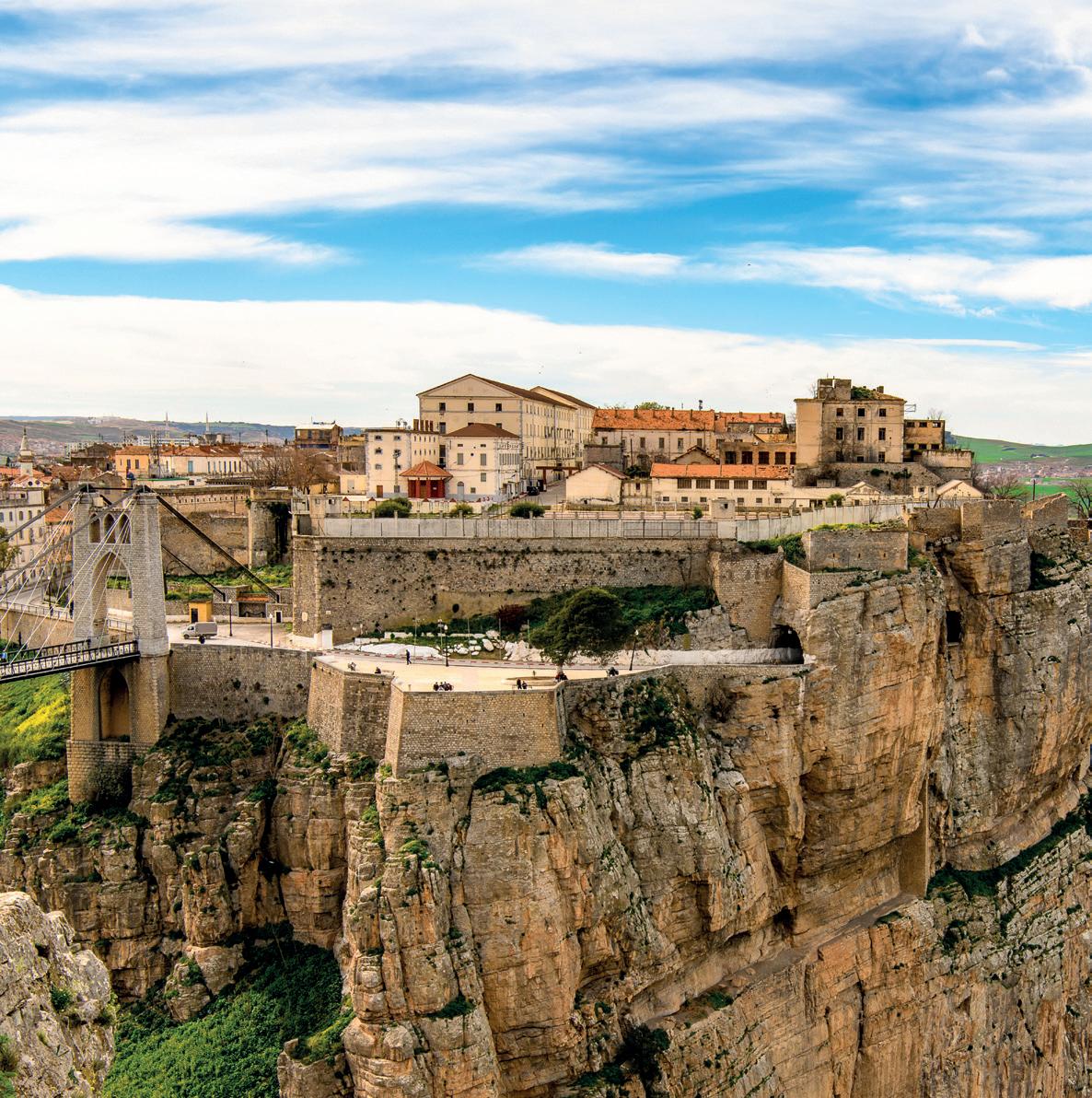
£0 SINGLE SUPPLEMENT PLACES AVAILABLE
“ I thoroughly enjoyed the whole experience and learnt a lot about the Roman influence on Punic and native culture over six centuries.”
Algeria is still one of the least-visited countries in the world, but access to its ruinous Classical cities is now easier than it has been for some years. The sites are a palimpsest of Numidian, Roman and Byzantine remains, and include probably the best-preserved colonia anywhere in the Empire – Timgad.
Day One | London - Algiers
Fly from London to Algiers and transfer to our hotel.
Day Two | Algiers
This morning we will visit two of the city centre museums: the Bardo Museum, housed in a neo-Moorish Villa with collections which focus on prehistory and the Museum of Antiquities and Islamic Arts. After lunch we will explore the Kasbah, built on the ruins of old Icosium, a Phoenician commercial outpost later overtaken by
the Romans. Little remains of its ancient past but having survived bombardment and civil war, the Casbah of Algiers remains the largest old walled city or ‘citadel’ in North Africa and was put on UNESCO’s list of World Heritage sites in 1992.
Day Three | Cherchell & Tipasa
We spend the whole of today along Mediterranean west of Algiers. Driving west we reach Cherchell, Phoenician Iol and Roman Caesarea, which was once the capital of the Numidian client King Juba II and his wife Cleopatra Selene, daughter of Mark

Anthony and Cleopatra. Our afternoon is spent at the Roman city of Tipasa, a UNESCO World Heritage Site overlooking the sea, with impressive remains both of the high Roman Empire, and of the early Christian period. We also stop at the huge cylindrical tomb, variously called the ‘Royal Mausoleum of Mauretania’ or the ‘Tomb of the Christian Woman’.
• Wander the perfectly preserved streets at the UNESCO-listed sites of Roman Djémila and Timgad
• In Sétif, gaze upon one of the most exquisite mosaics in all the Roman world – the fantastic ‘Triumph of Dionysus’
• Explore the Roman ‘City of Bridges’ – Constantine – and visit the evocative ruins of Hippo Regius
Today we fly to Annaba arriving in time for a late lunch and an afternoon visit to Hippo Regius. The great North African churchman later known as St. Augustine ended his days here in AD430, and we visit the remains of this once splendid city a mile to the south of modern Annaba. It was once a port, situated on an inlet which has since silted over, leaving the ruins isolated and complete, and now dominated by the basilica of St. Augustine which was built on a nearby hill during the 19th century. We visit the basilica as well as the site.
Constantine
We depart early this morning to visit the theatre and museum at Guelma. The Numidian Jugurtha won an important battle against the Romans here. We continue south to Khemissa, this relatively little-known or visited site was certainly a significant Numidian settlement from at least the second century AD. This huge ancient city is set in glorious surroundings, and among the ruins we find an old forum built on an artificial terrace on the north slope of the hill with shops and adjoining temples, as well as a Basilica dating probably to the second century AD. We then head west to Constantine, making one final stop to see the tomb of Massinissa and the site at El Khroub
Day Six | Tiddis & Constantine
Our morning is spent at the beautifully situated ruined city of Tiddis, an authentic Berber site modified by Roman civilization. Spectacularly located, the sandstone constructions at Tiddis have a distinctive ochre-red colour from the deep red of the earth in the surrounding area which is washed down from the hill-top and carried by the wind. The site has been occupied a least since the Neolithic period and several circular ‘bazina’ burial monuments from the pre-Roman Numidian period are visible at the site. We return to Constantine for lunch and later explore this extraordinary city, dramatically situated on a plateau by a deep ravine. Here we’ll see its museum, kasbah, suspension bridge and the Palace of Ahmed Bey, one of the finest Ottoman-era buildings in the country.
Day Seven | Constantine - Djémila - Setif We journey west to the site of Djémila situated on a narrow triangular plateau, 900m above sea level and described as ‘one of the most perfect expressions of the meeting of Roman power and African beauty’. The town here is thought to have been founded by either Emperor Nerva or Trajan between AD 96 – 117 initially as a military garrison. Despite the challenging topography of the undulating landscape, its builders tried to conform, largely unsuccessfully, to Roman grid planning
standards. It is partly owing to the consequent interesting layout and linear urban expansion and its good state of preservation that the site was granted UNESCO World Heritage status in 1982. In the afternoon we drive to Setif and end the day at the Setif Archaeological Museum, home to some unusual artefacts, but also some exceptional Roman mosaics including the ‘Triumph of Dionysus’.
Day Eight | Setif - Batna
This morning we drive south to Batna stopping en route to visit the Medracen Royal Tomb. This large cylindrical mausoleum dates to the 3rd-2nd centuries BCE and is believed to be the tomb of a Numidian King. We continue to Batna and arrive in time for lunch. In the afternoon we explore Lambaesis. This was the main military base of the Third Legion Augusta. The Legion may have numbered up to 25,000 men, recruited initially from Gaul, but later also from other Roman provinces and North Africa. The site is now rather forlorn, but parts of it, such as the amphitheatre and the four-sided arch in the military camp, are still quite substantial and worthy of some exploration.
Day Nine | Batna - Timgad - Biskra
We spend the morning at Timgad, the Roman city founded in AD 100 by Emperor Trajan, principally as a colony for veterans of the Legio III Augusta. This huge site was declared a UNESCO World Heritage site in 1982 and is famed for its formal orthogonal grid layout of the original town plan, measuring some 355m on each side, and for the good preservation of some of its monuments. Still visible is a rare example of a Roman Library and no less than eight bath complexes scatter the site. After lunch we continue south, driving through the spectacular scenery of the Aurès Mountains to the Biskra province which lies on the northern edge of the Sahara. We will stop on the way in the area of the gorges of Tighanimine and the breathtaking canyon of Rhouffi and we will visit the Balconies of Ghoufi where the cliffs cascade in naturally formed balconies and were used centuries ago to carve out cave dwellings from the sandstone.
We enjoy a relaxing morning visiting a traditional date Palmerie. For centuries, inhabitants of the Ziban have carefully planted and pollinated their precious date palms in the area – the local adage being ‘give to the date palm and she will return the favour’. There are more than 100 cultivars of dates produced from four million trees in Biskra, ensuring agriculture remains the lifeblood of the region’s economy. After lunch at the Palmerie, we transfer to Biskra airport for our flight to Algiers.
Farès K Moussa
Specialising in religious art and artistic practice, Farès has both written and researched on Romans and Phoenicians in Tunisia, Libya, Morocco and Sardinia, as well as on the subject of prehistoric rock art.

Day Eleven | Algiers - London
We transfer to Algiers airport for our return flight to London.
Please note that due to the unpredictable nature of local arrangements, some elements of our itinerary may be subject to change. In these circumstances, we will ensure that the integrity of our archaeological programme is not compromised but a certain degree of flexibility is required when travelling in this challenging but stunningly beautiful country.
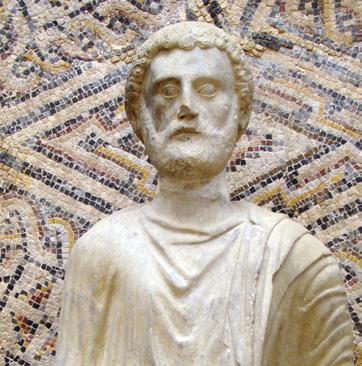
• Expert Guide Lecturer & Professional Tour Manager
• Entries to all sites as per the itinerary
• Field notes
• All taxes & gratuities
Included travel
• Return flights from London & all local transport Accommodation
• Accommodation in the Lamarz Arts Hotel, Sheraton Annaba Hotel, Protea Hotel by MarriottConstantine, Novotel Setif, Hotel Messouadi -
• Batna & Hotel Nail Zakaria - Biskra or similar
Culinary inclusions
• 11 breakfasts, 11 lunch & 11 dinners
• Water with all meals, tea or coffee with dinner
Dates & prices per person Date
Includes £300pp Special Offer discount if you book by 31st August 2024
For full details of this tour visit andantetravels.co.uk/aage
15 DAYS FROM £4,400pp

“ This was an excellent tour opening up a country that was new to me. A huge variety of interesting things to see and learn about, excellent team of tour leaders, good food and hotels, friendly travelling companions.”
Tunisia has some of the best preserved Roman cities in the world and many retain the romance of ruins in the countryside unspoiled by mass tourism. Starting with Carthage, we travel south through ruined towns of the high Roman Empire before continuing to the landscapes of the salt chotts, palm oases and dunes of the south.
Day One | London - Tunis
We fly to Tunis and check in to our hotel.
Day Two | Carthage
Today we explore what remains of that once great Phoenician city, Carthage. We start at the Byrsa Hill site, where Dido is said to have first founded her city, and we continue to the site of the Tophet, where the cremated remains of thousands of children were found. Later we visit the Cothon, the Punic harbour and the impressive Antonine Baths, ending our day at the amphitheatre.
Day Three | Oudna & Thuburbo Majus
Travelling south, we stop en route to examine a section of the longest aqueducts built in the Roman Empire. A short drive takes us Oudna, where we explore the remains of its substantial public buildings, before continuing to Thuburbo Majus, originally a Numidian settlement in the midst of rich farming country.
Day Four | Tunis - Dougga - Teboursouk
We journey to Dougga via Testour, a small town characterised by its unique blend of Spanish and local influences. Later, we visit the magnificent site of Dougga, perched high on the hill above olive groves. One of the oldest towns in Tunisia, Dougga

• Explore Tunisia’s historical sites from Carthage and Rome to fortified Berber villages
• Traverse the vivid white landscape of the chotts, its salt structures shaped by the desert wind
• View the mosques and medinas of Kairouan’s rich architectural and historical heritage
• Discover a treasure trove of Roman mosaics remarkable for the intricate beauty of their design
began life as a Numidian walled citadel and was built over by the Romans.
Day Five | Teboursouk - Musti - Kairouan
This morning we visit the ancient site of Musti Once a town of some importance, the site has been neglected and is still largely unexcavated. We continue north to Bulla Regia to explore its superbly preserved, subterranean Roman houses. After our visit here we start the long journey south to Kairouan.
Day Six | Kairouan
We spend the day in Kairouan, the fourth holiest city of Islam. We visit the Aghlabid pools, reservoirs built on the outskirts of the city in the 9th century, the Barber Mosque and also the Great Mosque – one of the major monuments of Islam and an architectural masterpiece. In the afternoon we explore the Medina with its network of winding streets, shops and courtyard houses.
Day Seven | Kairouan - Tozeur
We depart early this morning for our long drive south to Tozeur. We will stop en route to see the extraordinary wall at Bir Oum Ali. Reaching Tozeur around lunchtime, we will take a walk through the old town in the afternoon.
Day Eight | Tozeur
A day to relax or explore. Walk among the date palms, visit the rock formation of of Ong Jemal where Star Wars was filmed or choose to visit the oases of Chebika and Tamerza (pre-bookable, payable locally).
Day Nine | Tozeur - Douz
Today we cross the vast salt flats known as the chotts. A layer of superficial water can occasionally be seen during winter, but for most of the year the area is desiccated by the sun, leaving a residual film of salt. After lunch we visit Tamezret, a traditional village of the indigenous Amazigh people.
Day Ten | Douz & Matmata
During our last day on the fringes of the Sahara, we explore some of the unusual architecture of the region. We visit one of the troglodyte houses, which are scattered in and around Matmata, and we will also see a ksar, a form of fortified village, which is common in southern Tunisia.
Day Eleven | Douz - El Djem - Kairouan
Its an early departure this morning for our long return journey to the north. We will break our journey with a visit to El Djem, where we explore the massive amphitheatre – the sixth largest in the world. Afterwards we visit the museum, which houses some of the most impressive mosaics in
Tony O’Connor
A specialist in the Roman Empire, Tony has excavated widely across Britain, Europe and North Africa. He first led a tour for Andante over 10 years ago and he just gets better and better!

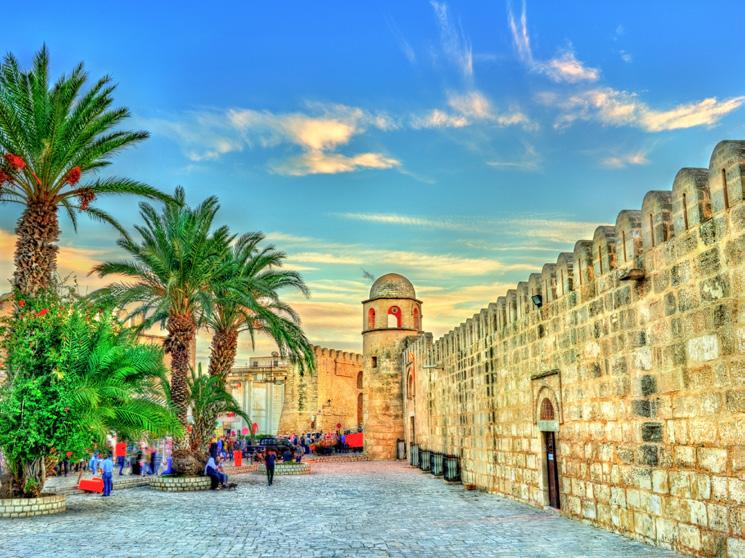
Tunisia, and outside in the museum gardens, the foundations of some large Roman townhouses –some with mosaics still in situ.
Day Twelve | Kairouan - Sousse - Hammamet
A rather more leisurely start awaits us this morning, with time to relax before we visit Sousse and its museum, housed in part of the Kasbah. The displays here include an exceptionally fine series of mosaics. Many are arranged on the floors and walls of the patio, and in a group of rooms beyond the garden. We continue to the coast and our hotel near Hammamet.
Day Thirteen | Kerkouane & Nabeul
Today we travel along the beautiful coastline of the Cap Bon peninsula to Kerkouane, considered to be the best preserved Punic town in Africa. After lunch we continue to Nabeul to see its small museum before visiting the site of ancient Neapolis, a city founded by Greek immigrants in the 5th century BC.
Day Fourteen | Tunis
This morning we visit the world-famous Bardo Museum, which ranks alongside the Egyptian Museum in Cairo as one of the two great museums in North Africa. In the afternoon we will take a walk through the narrow streets of the 9th century medina, a UNESCO World Heritage site, before returning to our hotel in Hammamet for some free time.
Day Fifteen | Hammamet - Tunis - London
Our tour comes to an end and we return to the airport for our flight to London.
• Expert Guide Lecturer & Professional Tour Manager
• Entries to all sites as per the itinerary
• Field notes
• All taxes & gratuities
Included travel
• Return flights from London & all local transport
Accommodation
• Accommodation in the Hotel Dar Said, Hotel Thugga, La Kasbah Hotel, Hotel Dar Horchani, a hotel in Douz & Hotel Sindbad or similar
Culinary inclusions
• 14 breakfasts, 13 lunch & 14 dinners
• Water with all meals, wine & tea or coffee with dinner
Dates & prices per person
Date Twin/Dbl Share SS 10th - 24th Feb £4,650 £4,400 £595
Includes £250pp Special Offer discount if you book by 31st August 2024
For full details of this tour visit andantetravels.co.uk/anst
16 DAYS FROM £10,025pp

Southern Africa’s vast and open expanses hide a wealth of archaeology – from some of the earliest evidence of human ancestors who left behind stone tools and skeletons to kingdoms who traded gold and ivory beyond China. There are thousands of Stone Age sites in the wild, caves and rock shelters, inland and along the coast, that have recorded the way of life and history of people in the region over nearly two million years. From the famous Sterkfontein Caves to the relatively unknown archaeological treasures over the border in Zimbabwe, this is a fabulous opportunity to explore the far depths of the human past in the company of an expert in human origins while revelling in the magnificent Savannah landscapes in which humankind developed.
Day One & Two | London - JohannesburgMaropeng
We take an overnight flight to Johannesburg and arrive in the morning of Day Two. On arrival we continue to Maropeng where we start our introduction to human origins with a visit to the Maropeng Visitor Centre. Later, we transfer to our hotel and check in.
Day Three | Sterkfontein Caves & Swartkrans
Continuing our exploration of the Cradle of Humankind, we start today with the Sterkfontein
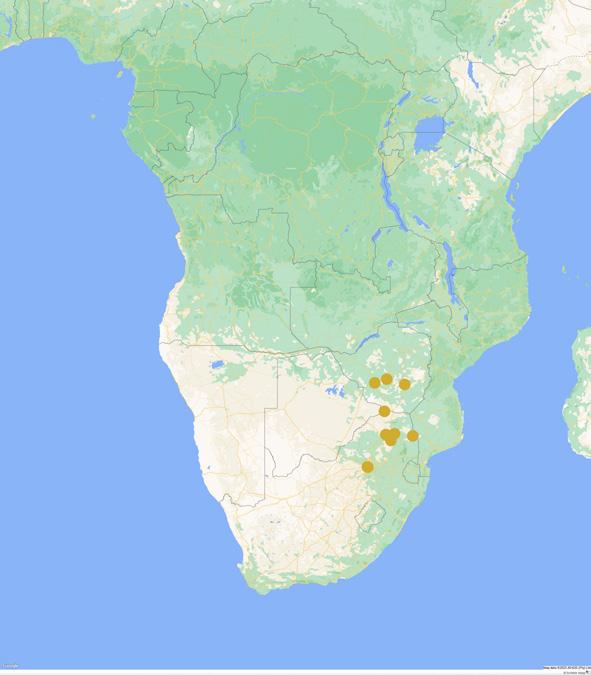
Caves. Finds here included the 2.1-million-year-old Australopithecus skull, and “Little Foot”, an almost complete skeleton more than three million years old. In the afternoon we visit nearby Swartkrans, rich in archaeological material and a prominent fossil site.
Day Four | Braamfontein
We visit two important museums today. First, the Origins Centre in Braamfontein. The centre displays an extensive collection of rock art from the Rock Art Research Institute at Wits University and
follows the path of hominin innovation that began over two million years ago. Offering a stark contrast to the morning, we visit the Apartheid Museum in the afternoon, a superb example of design, space and landscape offering the international community a unique South African experience. The Apartheid Museum is critical to our understanding of this beautiful and troubled country.
Day Five | Maropeng - Polokwane
This morning we journey north to Polokwane in Limpopo, stopping en route at Arend Dieperink
• Discover the UNESCO World Heritage Sites of the Cradle of Humankind and Great Zimbabwe
• Adventure into the bush on a walking rock art safari at Berg en Dal
• Admire the paintings depicted at Koaxa’s Shelter, opening up the hidden world of the ancient San people
• Explore Mapungubwe, one of the glories of South African archaeology
Museum to set the scene for tomorrow’s explorations. The museum charts the history of the town and its surroundings from the discoveries at Makapan’s Cave right through to the Anglo-Boer War. Here we will take a step back in time to look at the cultural heritage of the Afrikaans people, particularly in what is now Limpopo province, but was once Transvaal, one of the three Boer Republics.
Day Six | Makapansegat
Transferring to 4x4s, we travel to Makapansegat, an important Palaeolithic site that is littered with caves. At Makapansgat we will gain insight into one of the most famous hominin sites in the world – the Limeworks Cave. Searches here revealed remains of about 40 individuals of Australopithecus africanus a species of hominin dating from 2.5 to 3 million years ago or more. Moving on in time we visit the Cave of Hearths which will show us something of how hand axe makers lived half a million years ago and the importance of their surrounding landscape to their survival.
Day Seven | Polokwane - Mapungubwe
National Park
We make our way to Mapungubwe National Park, an expansive Savannah landscape which was once a large kingdom before its abandonment in the 14th century. We explore the bush land and climb up to the site’s lost city on the Mapungubwe Hill. Mapungubwe is one of the glories of South African archaeology. A little earlier than its more famous neighbour Great Zimbabwe, this city was connected through its trading links to an Indian Ocean-sized trading web, which reached to India and the great imperial court of far off China. This magical place is a must see.
Day Eight | Mapungubwe - Tzaneen
Today we drive to Koaxa’s Shelter in our search for rock art. The paintings depicted here will take your breath away and open up the hidden world of the ancient San people. You can almost hear them
conversing in their klick language as they painted their experiences and beliefs. These 200 images of fine detail, depicting at least 16 animal species including lion, hyena, mongoose and locusts.
Day Nine | Tzaneen - Kruger National Park
We continue south to Kruger National Park today, one of the prime game-watching destinations in the world. This area has an incredibly diverse ecosystem and is home to an impressive array of wildlife: lions, cheetah, rhinos and buffalo wander a 20,000km square expanse of parkland. We arrive in time for lunch and a late afternoon game drive.
Day Ten | Berg en Dal
An adventure today at Berg en Dal, where we walk through the bush on the hunt for rock art scattered on boulders across the landscape. The sites here bring us face-to-face with the modern difficulties of preservation. The beauty and fragility of the rock art scattered amongst the bush will stay with you. We have some free time today to relax and rest before our return to Johannesburg.
Day Eleven | Kruger National ParkJohannesburg
After an optional early morning game drive, we make the journey back to Johannesburg where will stay before our onward travel to Zimbabwe tomorrow.
Day Twelve | Johannesburg - Bulawayo - Great Zimbabwe
We take a flight from Johannesburg to Bulawayo this morning arriving in time for lunch. In the afternoon we journey to Great Zimbabwe, known locally as “Dzimba Dzamabwe” meaning the house of stone or stone buildings. We will overnight nearby ready for our site visit tomorrow.
Day Thirteen | Great Zimbabwe
We dedicate most of our day to the extensive site of the Great Zimbabwe, the largest and most important capital of the vast Shona Kingdom
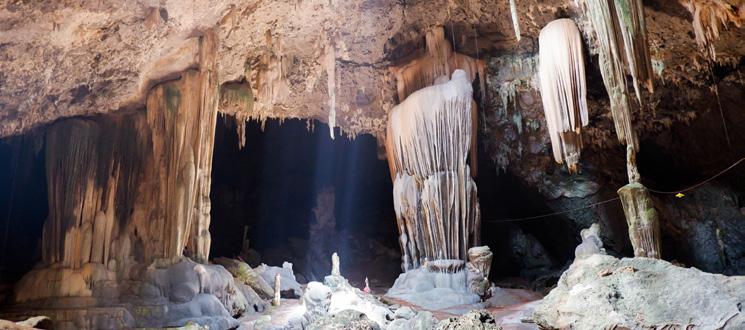

which at its peak controlled 100,000 km² between the Zambesi and Limpopo rivers. We examine its extraordinary stonework and the fascinating architecture of its Great Enclosure as well as the finds from the site displayed at its museum. There will be some free time in the afternoon to spend relaxing or you could choose an optional game drive in the Lake Mutirikwi Recreational Park.
Day Fourteen | Great Zimbabwe - NalataleBulawayo
We make our way back to Bulawayo stopping en route at the Madzimbabwe of Nalatale, in the remote Somabula Flats in central Zimbabwe. Nalatale was once the capital of the Butua Kingdom, which rose to prominence following the decline of Great Zimbabwe. The ruins are unique for their intricate herringbone, chevron and chequer-patterned stone walls.
Day Fifteen & Sixteen | Bulawayo - KhamiJohannesburg
Our last site visit is a short trip to Khami on the outskirts of Bulawayo. Continuously inhabited for 40,000 years, Khami was the court of the Rozvi’s Mombo dynasty and later an important spiritual shrine of the Ndebele. This afternoon we take a flight to Johannesburg to connect with an overnight flight to arrive back in London the next day.
Your comprehensive expert guided tour includes
• Expert Guide Lecturer & Professional Tour Manager
• Entries to all sites as per the itinerary
• Field notes
• All taxes & gratuities
Included travel
• Return flights from London & all local transport Accommodation
• Accommodation in Johannesburg, Polokwane, Mapungubwe National Park, Tzaneen, Kruger National Park, Great Zimbabwe & Bulawayo
Culinary inclusions
• 13 breakfasts, 13 lunches & 13 dinners
• Water with all meals, tea or coffee with dinner
Dates & prices per person
Date Twin/Dbl Share SS
31st Mar - 15th Apr £10,675 £10,025 £825
Includes £650pp Special Offer discount if you book by 31st August 2024
For full details of this tour visit andantetravels.co.uk/asaz
7 DAYS FROM £4,610pp

Archaeology in Egypt is seeing another Golden Age, this time led by local Egyptians themselves. With new technology and work undertaken in the last 10 years, countless projects are coming to fruition revealing often surprising detail about the ancient Egyptians and how they lived from engineering ingenuity to insights into their beliefs. It is clear that Ancient Egypt is not done giving up her secrets. Alongside these remarkable discoveries, the redesign and modernisation of existing museums, together with the creation of regional museums, means that many precious artefacts which have been languishing in a basement, some as far back as the Victorian age, are now on display.
This tour focuses on these new discoveries from the recently excavated tombs in Saqqara to the newly renovated Greco Romano Museum in Alexandria and the long-awaited, much anticipated brand new Grand Egyptian Museum at Giza. Returning to these sites in the engaging company of our experienced excavators and Egyptologists is a treat not to be missed.
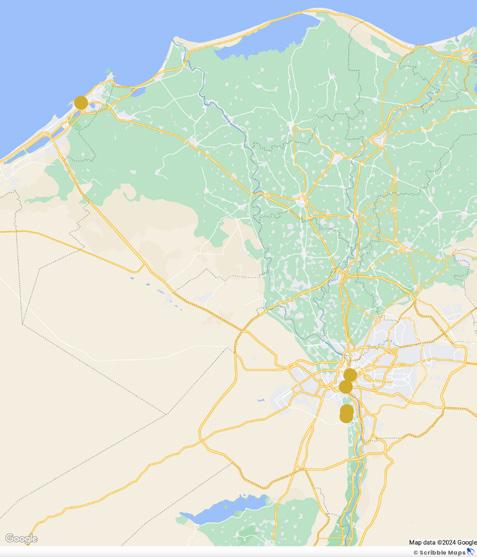
• Visit the long-awaited and much anticipated Grand Egyptian Museum at Giza
• In expert company explore the Imhotep Museum at Saqqara and Greco Roman Museum in Alexandria both recently opened
• New tomb discoveries in Saqqara including the Tomb of Mehu and the Tomb of Maia
• Spend two days in Alexandria; the capital of the Ptolemies, one of the greatest cities of the Hellenistic and Roman world
We depart from London and arrive in Cairo –this buzzing, energetic metropolis that is Egypt’s extraordinary capital and a city that Egyptians admiringly refer to as ‘the Mother of the World’.
We dedicate today to one of the most archaeologically important sites in Egypt - the sprawling necropolis of Saqqara. Here were buried some of the most important officials of Memphis and it was also the place of Egypt’s first pyramid. Here we will see the Tombs of Maya and Horemheb and the recently opened Old Kingdom Tomb of Mehu, subject of the excellent 2020 documentary ‘The Secrets of Saqqara’. In the afternoon we shall explore the Imhotep Museum which has re-opened after 2 years of renovation. Our day at Saqqara completes with the Tomb of Maia who was wet-nurse to Tutankhamun and the Tomb of Nemtymes both re-opened to the public in the last decade.
Our day starts at the National Museum of Egyptian Civilisation. The NMEC opened in 2017 and is the first of its kind to display the richness and diversity of Egyptian civilization throughout the ages, from prehistoric times to the present day. The museum’s exceptional collection includes the royal mummies, which are exhibited in a new interactive display using 21st century cutting-edge technology to go beneath the wrappings and reveal their secrets, in addition to shedding light on the rituals and religious beliefs surrounding mummification in ancient Egypt. After lunch we leave Cairo on the desert road and travel to Alexandria.
Our focus this morning is the fabulous GraecoRoman Museum which re-opened its doors to the public in 2023 after 18 years of renovation work.
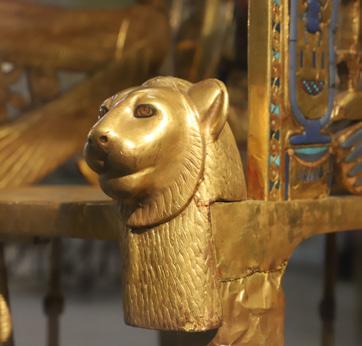
archaeology of ancient Egypt, Lucia has been leading tours to this country for over 20 years.

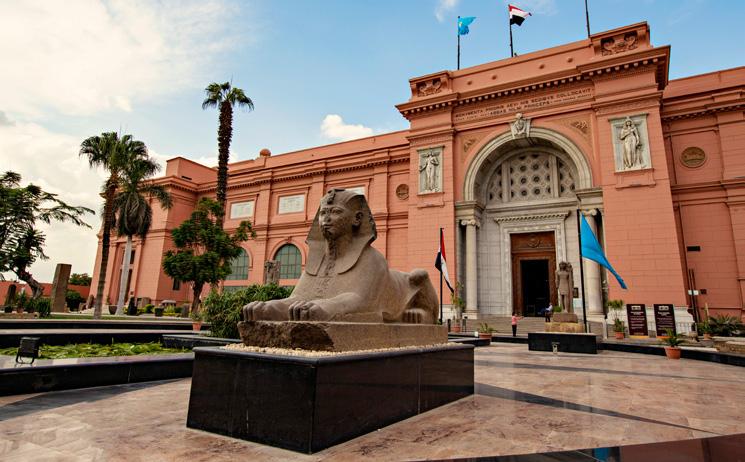
Dedicated to the Greek and Roman eras of Egypt, exhibiting artefacts from Alexander the Great’s occupation, the subsequent Ptolemaic Dynasty, and the period of Roman rule to province up to the Muslim conquest. Among the thousands of artefacts on display are several discovered during underwater excavations in the sunken cities of Thonis-Heracleion and Canopus as well as in the ancient Portus Magnus of Alexandria. In the afternoon we visit the Bibliotheca Alexandrina Here we will see superb mosaics recovered from the royal palace of the Ptolemies and the excellent Manuscripts Museum. There is so much more to see here than most people realise.
We leave the city centre and drive to Abu Sir, ancient Tapaposiris where the Ptolemaic temple and a funerary monument modelled on the Pharos were built on a ridge between lake Mareotis and the Mediterranean. Recently there has been much speculation that it may contain Cleopatra’s tomb which as yet, remains undiscovered. After lunch we return south to Cairo.
A full day devoted to the Great Egyptian Museum which sits on the edge of the Giza plateau with the pyramids within view. A huge undertaking which started over 20 years ago, the Museum boasts over 750,000 sqm in floor size, 12 exhibition halls and thousands on thousands of artefacts. At 45m long, the cedarwood Solar Boat of King Khufu once housed in a cramped exhibition hall at Giza now fits easily within the vast space of the GEM and two exhibition halls are entirely devoted to Egypt’s most
famous pharaoh, Tutankhamun alone. For the first time, almost all of the 5,000 objects discovered in his tomb will be on display. Costing nearly a billion dollars in its creation, this is the biggest Museum in the world.
We return to Cairo airport for our flight home to London.
• Expert Guide Lecturer & Professional Tour Manager
• Entries to all sites as per the itinerary
• Field notes
• All taxes & gratuities
Included travel
• Return flights from London & all local transport Accommodation
• Accommodation in Cairo & Alexandria
Culinary inclusions
• 6 breakfasts, 5 lunch & 5 dinners (plus 1 snack in hotel room due to late arrival)
• Water with all meals, tea or coffee with dinner
Dates & prices per person
Date Twin/Dbl Share SS
28th Jan - 3rd Feb £4,860 £4,610 £730
Includes £250pp Special Offer discount if you book by 31st August 2024
For full details of this tour visit andantetravels.co.uk/aenm
12 DAYS FROM £7,590pp
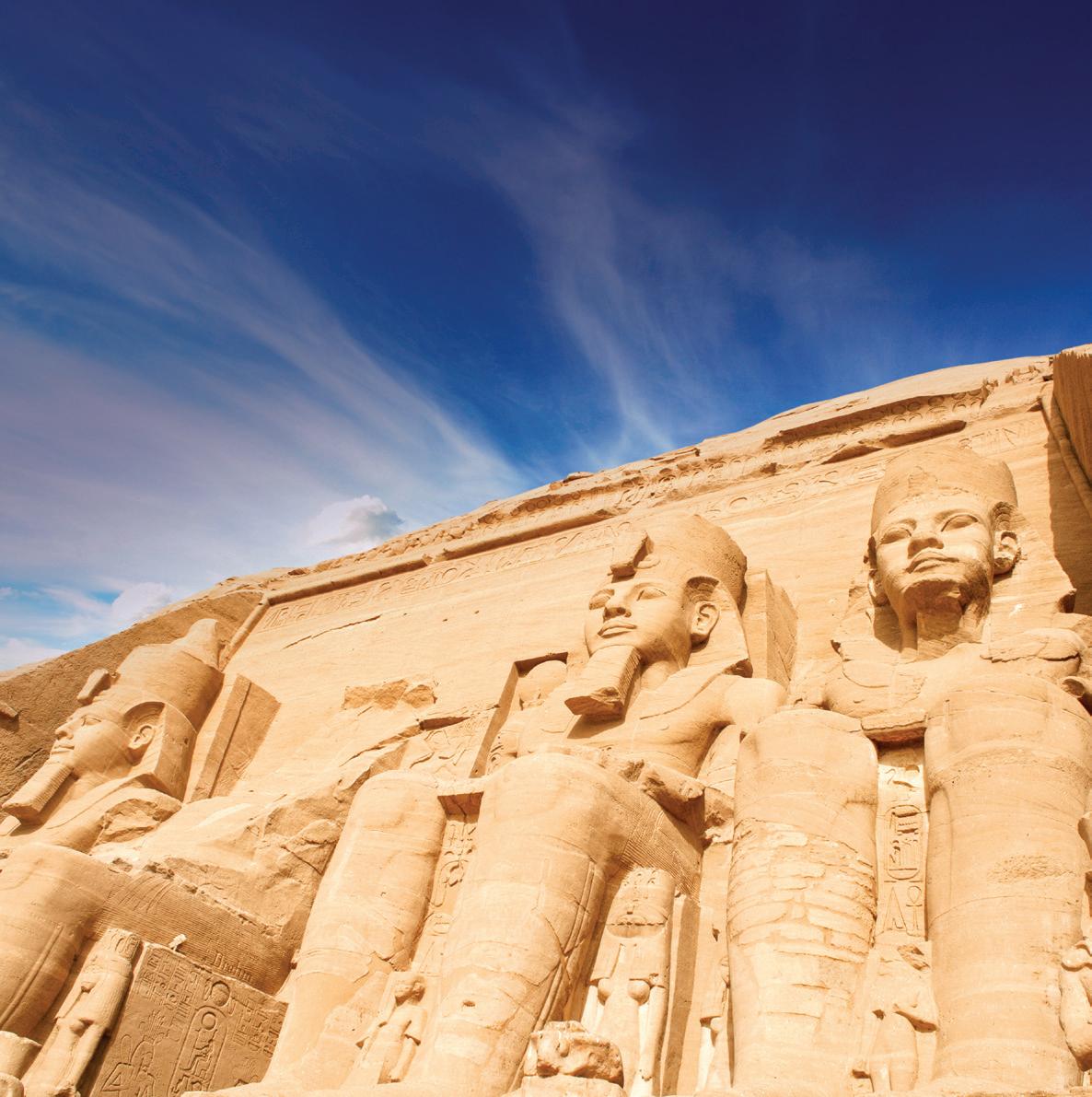
Activity Level
“ I thoroughly enjoyed the tour. It was a wonderful introduction to ancient Egypt. The tour manager and guide were impressive and the accommodation excellent.”
The archaeology of ancient Egypt is one of the most instantly recognisable of all the great civilisations. This is a narrative of power, vision and ambition. The monuments of Egypt are much more than dry and dusty stones – through the expertise of our Guide Lecturers, we get to ‘meet’ the real ancient Egyptians.
We depart from London and arrive in Cairo –this buzzing, energetic metropolis that is Egypt’s extraordinary capital – a city that Egyptians admiringly refer to as ‘the Mother of the World’.
We devote our day to Saqqara, the vast necropolis to the ancient Egyptian capital of Memphis
We discover the extraordinary Step Pyramid of Djoser, the smooth-sided Pyramid of Unas and the Mastaba of Mereruka. Later we explore the fabulous Serepeum, catacombs for the sacred Apis bulls and the the recently reopened Imhotep Museum.
This morning, we pay a visit to the pyramid complex on the Giza Plateau, including the Great Pyramid – a true wonder of ancient world, where atmospheric passageways lead to the breathtaking grand gallery and royal burial chamber. We also explore the Valley Temple of Khafra and the enigmatic Great Sphinx. In the afternoon, we enjoy a visit to the new Grand Egyptian Museum*, where the world’s most extensive exhibition in pharaonic artefacts can be seen. Among the treasures on display are the solid gold mask of Tutankhamun and the Narmer Palette. The new museum is also now home to King Khufu’s Solar Boat
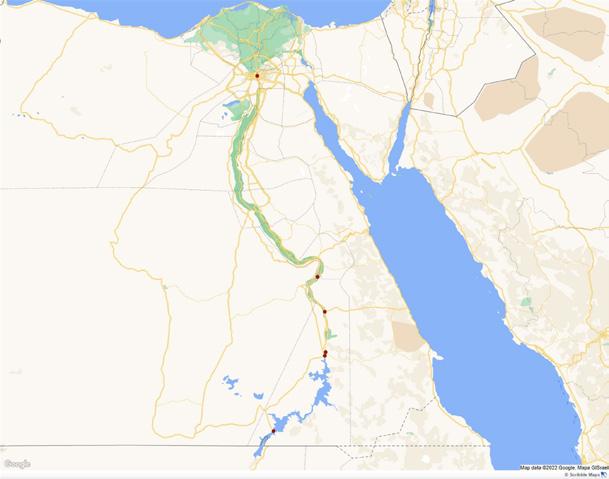
• Experience the delights of cruising the famous River Nile
• Discover the impressive temple site of Abu Simbel
• See the grand gallery as well as the royal burial chamber of the Great Pyramid of Khufu
• Explore the enigmatic Valleys of the Kings and Queens, and pay a visit to the exceptionally well-preserved tomb of Nefertari
We start with a visit to the pyramid complex at Dahshur where we discover the Bent Pyramid and the Red Pyramid, two well preserved early constructions built during the reign of King Sneferu. Afternoon site visits include Memphis, founded over 5000 years ago and The National Museum of Egyptian Civilisation whose exceptional collection includes the royal mummies. This evening we fly from Cairo to Luxor.
Our first visit of the day is to the Memorial Temple of Hatshepsut at Deir el-Bahri, a stunning collection of shrines that have been heavily restored to reflect their former glory. In the afternoon, we visit the famous Colossi of Memnon, two enormous statues of the Pharaoh Amenhotep III standing at a towering 18-metres high, erected to guard the entrance of the pharaoh’s memorial temple. Afterwards, we visit the Qurna tombs of Ramose, Userhet and Khaemhet and Deir El Medina, the village of the workers who constructed the tomb in the Valley of the Kings.
The Valley of the Kings awaits us today. This was the final resting place of royals and nobility for almost 500 years, with excavations dating the site back as far as the 16th century BC. Its most notable occupant is, of course, King Tutankhamun, so famously discovered by Howard Carter in 1922, and since returned to his original burial place where he now lies undisturbed. After lunch, we visit the Valley of the Queens, which includes the exceptionally preserved Tomb of Nefertari, who was the wife of Pharaoh Ramesses II.
This morning we lose ourselves in the captivating complex of Karnak. Here we encounter the cult temple of Amun-Ra, chief of the deities of the New Kingdom. This is a spectacular multi-period location with a wealth of religious and historical inscriptions at every turn. In addition to its religious significance, it also served as a treasury, administrative centre, and palace for the New Kingdom pharaohs. Added to by generation after generation of pharaohs over a period of 1500 years, it’s a dazzling maze of monumental gateways, obelisks, pillared halls and subsidiary shrines. From Hatshepsut, Seti I and Rameses II to the Ptolemies, Romans, and early Christians; all have left their mark here. After checking into our cruise boat and having lunch on board we make our way to the Ramesseum, with its fallen colossus of Ramesses II, an astounding testament to the Pharaohs reign – and the inspiration behind Percy Bysshe Shelley’s
Dr Elizabeth Bloxam
Visiting Professor of Egyptology at North East Normal University in China, Elizabeth held an Honorary Senior Research Associate post at University College London for the last 10 years.


masterpiece ‘Ozymandias’. Afterwards we make our way to Medinet Habu, arguably the bestpreserved temple of the New Kingdom, filled as it is with a wealth of exemplary paintings, carvings and sculptures. In total, the precinct contains over 7 square kilometres of decorated reliefs.
Before we set sail this afternoon we visit the fantastic Luxor Museum - a masterfully arranged collection of archaeological artefacts and home to celebrated works of art, including the famous statue of Tuthmosis III, and Luxor Temple with its avenue of sphinxes, military reliefs and gorgeous papyrus columns.
Day Nine | Edfu - Kom Ombo
We make our way to the temples of the gods of Upper Egypt, starting with the Temple of Horus at Edfu. Towering at a jaw-dropping 37 metres, it’s decorated with vivid scenes of King Ptolemy VIII destroying his enemies before Horus. The complex even houses an Nilometer, a structure made to measure the depth and clarity of flooding Nile water. This afternoon, we explore the Temple of Sobek and Horus the Elder at Kom Ombo and the site’s Crocodile Museum.
Day Ten | Philae - Aswan
Today we make our way to ancient Egypt’s southern border and visit the impressive Temple of Isis in Philae. The flooding of Lake Nasser caused the whole complex to be moved from its original location. After a stop at Aswan (High) Dam, we visit the ancient Quarries at Aswan, famous as the source of pink granite which was widely used in many pharaonic monuments and site of the spectacular ‘Unfinished Obelisk’.
Day Eleven | Aswan - Abu Simbel - Cairo
It’s an early morning start as we disembark the MS Tulip and transfer to Aswan Airport and fly to
Abu Simbel. Here, we make the most of our last day exploring what is considered to be Egypt’s most impressive temple site, home to temples of Ramesses II and Nefertari. After lunch, we fly to Cairo, where a farewell dinner awaits this evening.
Day Twelve | Cairo - London
Today we catch our return flight back to London. *subject to the new museum being open
• Expert Guide Lecturer & Professional Tour Manager
• Entries to all sites as per the itinerary
• Field notes
• All taxes & gratuities
Included travel
• Return flights from London & all local transport Accommodation
• Accommodation in the Sofitel El-Gezirah, Pavillon Winter Luxor Hotel, 4 nights aboard MS Tulip & Le Meridien Cairo Airport or similar
Culinary inclusions
• 11 breakfasts, 10 lunches & 10 dinners (plus 1 snack in hotel room due to late arrival)
• Water with all meals, tea or coffee with dinner (all other drinks in the hotels and on board the ship are payable locally)
Dates & prices per person
Includes £400pp Special Offer discount if you book by 31st August 2024
For full details of this tour visit andantetravels.co.uk/aegh
19 DAYS FROM £13,570pp
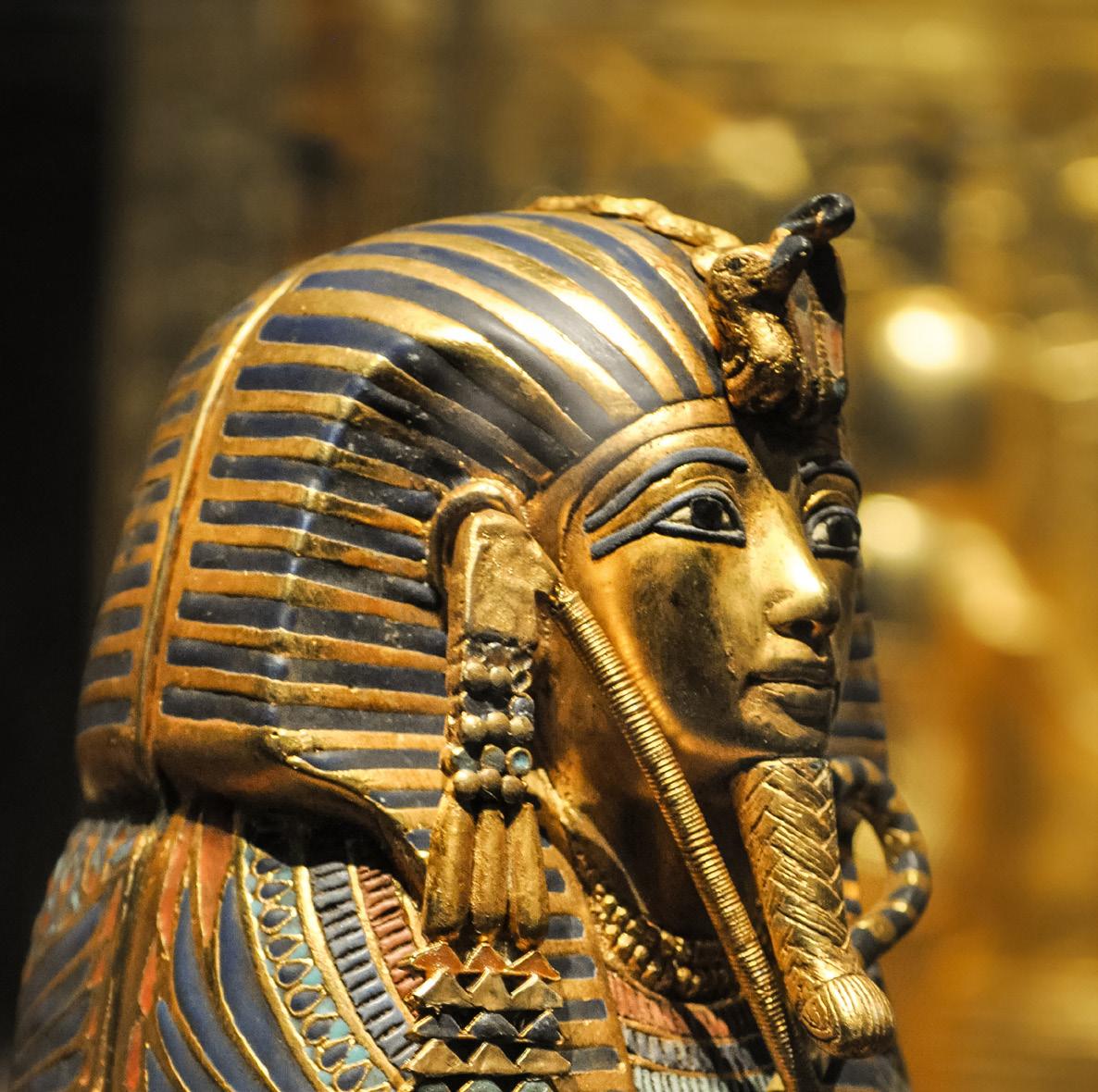
Howard Carter’s description of his first sight into Tutankhamen’s tomb is also a fitting description of Andante’s exploration of the archaeology of this amazing country. Egypt is indeed a land of ‘wonderful things’, a country where adjectives are insufficient to describe the monuments and experiences which are not to be found anywhere else in the world. While certain images of Egypt have become familiar, there is no substitute for witnessing at first hand the glittering treasures of Tutankhamen’s tomb, the quiet intrigue of the hypostyle hall at Karnack, the beautiful setting of the Temple of Isis at Philae or standing over-awed at the feet of the colossal statues of Ramesses II at Abu Simbel. This epic tour encompasses all of these iconic sites and so much more. Starting with the Old Kingdom and the ‘Age of the Pyramids’ and ending with the Ptolemaic Dynasty and the Romans, we take a journey of a lifetime as we explore Upper and Lower Egypt travelling through the millennia.
Day One | London - Cairo
We depart from London and arrive in Cairo –this buzzing, energetic metropolis that is Egypt’s extraordinary capital and a city that Egyptians admiringly refer to as ‘the Mother of the World’.
Day Two | Saqqara
We dedicate today to one of the most archaeologically important sites in Egypt - the
sprawling necropolis of Saqqara. Here were buried some of the most important officials of Memphis and it was also the place of Egypt’s first pyramid. We will discover the 3rd Dynasty Pharoah Djoser’s distinctive Step Pyramid complex and the smoothsided Pyramid of Unas as well as the Imhotep Museum (due to reopen late 2023 after extensive renovation). After lunch we return to focus on the lesser-visited parts of this huge site and visit two

• Journey to the Middle Nile and discover the city of the heretic pharaoh Akhenaten at Tell el-Amarna
• Admire the exquisite artistry of the special tombs of Nefetari, Seti I, Sennefer and Rekhmire
• Enjoy privileged access at Tapaposiris, conjectured to be the site of Cleopatra’s burial
• Spend a whole day at Saqqara where we discover sites seldom viewed by the casual visitor
important tombs, the mastaba of Mereruka, a large and complex tomb of the Vizier to King Teti, and the superb mastaba tomb of Ti as well as the Serapeum, burial place of the sacred Apis bulls in the northern part of the Saqqara complex.
This morning we visit the best preserved of the Seven Wonders of the World, the Great Pyramid of Khufu (Cheops) which towers some 481 feet (147 meters) above the plateau, its estimated 2.3 million stone blocks each weighing an average of 2.5 to 15 tons. But there is a great deal more to the site. We will also discover the Pyramids of Khafre and Menkaure as well as the enigmatic Sphinx carved from a knoll of rock left in one of the stone quarries used to provide stone for the pyramids and tombs at Giza. Its face probably represents Khafra, but arguments have been made for Djedefra and recently for the Sphinx being much older than the pyramids themselves. In the afternoon, we visit the Great Egyptian Museum* where the world’s most extensive exhibitions in pharaonic artefacts can be seen. Among the many treasures on display are the solid gold mask of Tutankhamun, and the Narmer Palette, thought to depict the unification of Upper and Lower Egypt. The new museum is also home to King Khufu’s Solar Boat.
We set off early for Beni Hassan this morning, winding our way out of the traffic heavy roads of Cairo and onto the fast highway to Minya. The journey will take us around 4 hours as we travel through the desert tracking the Nile. Our goal is the site of Beni Hassan, just south of Minya. These rock cut tombs high in the desert cliff overlooking the Nile take a little effort to reach but the view from the top is breath-taking and the tombs are fabulous. These Middle Kingdom tombs are painted, rather than decorated in carved reliefs and covered in scenes of daily life in extraordinary detail. These include scenes of agriculture, crafts, fishing, fowling and hunting. We overnight in Minya, now a small city mostly overlooked by tourists but once a powerful regional capital within Egypt.
Today we visit Tell el-Amarna, one of the most important archaeological sites in Egypt. It is also one of those which is usually ignored or given scant attention by tour operators because there are no monumental structures here. Amarna is, however, the most significant surviving city site from ancient Egypt; the majority having been built over by later settlements. It was also a new Capital city, constructed by Amenhotep IV beginning in
A specialist in the archaeology of ancient Egypt, Lucia has been leading tours to this country for over 20 years.

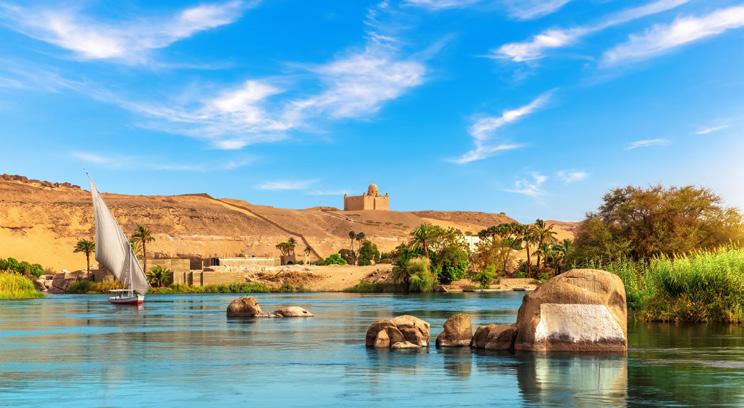
the 5th year of his reign. The original name of the city was Akhenaten, the ‘Horizon of the Aten’, a title corresponding to the actions of the so-called ‘heretic Pharaoh’ Akhenaten as he later became to be known. The city itself was abandoned after the Pharaoh’s death, only 20 years or so after its creation. Here, we visit the tombs of important priests Meryre and Panehesy as well as the Royal Tomb of Akhenaten, Nefertiti’s Palace, and the Temple of Aten.
Day Six | Minya - Tuna el-Gebel - Abydos
Our day starts at the rich and varied archaeological site of Tuna el-Gebel which functioned as the necropolis for the ancient town of Khemnu/ Hermopolis at the edge of the western desert. It marks the boundary of Akhenaten’s city some 11kms from the centre of Tell el- Amarna and is home to one of Akhenaten and Nefertiti’s ‘boundary stelae’ carved into the limestone cliff. We also visit vast catacombs for ibis and baboons, associated with the god Thoth, and impressive tombs, including that of a High Priest of Thoth c300 BC – Petosiris, whose reliefs combine Greek and Egyptian artistic styles. In the afternoon, we continue our drive south to Abydos.
Day Seven | Abydos – Dendera - Luxor
This morning we visit Abydos, one of the most sacred sites in Egypt, identified as the burial place of Osiris. The main focus of our visit is the important cult temple of Seti I with its fabulous wall decorations, some of the finest of the New Kingdom. The temple is also the home of the only King List still to remain in situ. After a picnic lunch we continue to Dendera once the capital of the Sixth Upper Egyptian nome. Like Saqqara it was the site of burials of sacred animals, particularly
cows associated with the cult of the local goddess Hathor. The roof of the temple includes a number of chapels, symbolic mortuary chapels for Osiris. One of these contained the famous Dendera Zodiac, which is now in the Louvre Museum in Paris, but it is replicated here in situ by a circular plaster cast depicting the hours of the day and night as well as the journey of the sun, moon, and stars across the sky.
This morning we cross the river by motorboat and then travel by coach, to visit the famous Colossi of Memnon on the West Bank at Thebes. These two enormous statues of the Pharaoh Amenhotep III stand at a towering 18-metres high and were erected to guard the entrance to the pharaoh’s vast and opulent memorial temple. Alas, only traces of that once-great temple remain. Next, we visit the Valley of the Kings. Here on the west bank is the necropolis area reserved for royal burials from Continued...


around 2100 BCE, but it was the Pharaohs of the later New Kingdom period, who chose these once remote desert valley sites for their grand rock-cut tombs. Of over 60 tombs discovered in the Valley of the Kings, only a small number are open to the public and we enter a selection of these, including the elaborately decorated tomb of Seti I, which details the opening of the mouth ceremony. In the afternoon we visit Deir el-Medina. This is a special place because here, perhaps more than anywhere else in Egypt, we come closest to the daily lives of a group of individuals living in a community. This was no ordinary community however, but the settlement of the craftsmen responsible for constructing the tombs in the Valley of the Kings, and as such employees of the state.
This morning we return to the west bank and the Valley of the Queens where we visit its most famous tomb, that belonging to the Chief
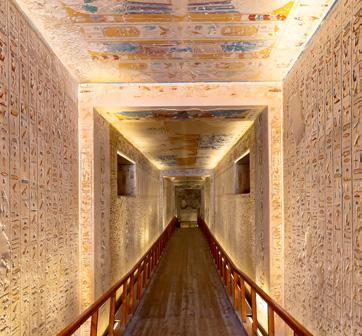
Wife of Ramesses
The tomb has vividly painted reliefs with inscriptions describing the queen’s beauty, sweetness and charm and the decoration is exquisite. We continue to the Ramesseum, with its fallen colossus of Ramesses II, an astounding testament to the Pharaohs reign – and the inspiration behind Percy Bysshe Shelley’s masterpiece ‘Ozymandias.’ Later we make our way to Medinet Habu, arguably the bestpreserved temple of the New Kingdom, filled as it is with a wealth of exemplary paintings, carvings and sculptures. In total, the precinct contains over 7 square kilometres of decorated reliefs.
We start today at the Memorial Temple of Hatshepsut at Deir el-Bahri, a stunning shrine cradled by the dramatic natural sculptures of neighbouring cliffs. The site is often regarded as one of the most spectacular and beautiful in Egypt although the temple to which visitors now come, is not the first on the site, nor is it entirely original in its architecture! It is famous for its scenes showing a trading expedition to the land of Punt where the Egyptians traded with the local people for exotic products, including incense trees. Next we visit Howard Carter’s House – the property used by the archaeologist during his search for the tomb of Tutankhamun and eventual discovery and to round off the day we will visit to the excellent Luxor Museum, where we see a masterfully arranged collection of archaeological artefacts and celebrated works of art, including the famous statue of Tuthmosis III, an extraordinary figure carved out of greywacke and an alabaster figure of Amenhotep III protected by the great crocodile god Sobek.
We spend the morning at Karnak, exploring the largest temple complex in Egypt, and some have argued, the largest religious complex in the world. In addition to its religious significance, it also served as a treasury, administrative centre, and palace for the New Kingdom pharaohs. Added to by generation after generation of pharaohs over a period of 1500 years, it’s a dazzling maze of monumental gateways, obelisks, pillared halls and subsidiary shrines. From Hatshepsut, Seti I and Rameses II to the Ptolemies, Romans, and early Christians; all have left their mark here. In the afternoon, we visit Luxor Temple, linked to the Karnak complex by an avenue of sphinxes, processions would travel along this 1.5k mile route on a regular basis. There were barque shrines where the boats, which carried the image of the god, could be placed and where ceremonies could be conducted. At the end of the day, we embark on our Nile cruise and the first of our 4 nights on board.
Before we set sail today, we make one last visit to the west bank and the ‘Tombs of the Nobles. Here we see two of the most splendid non-royal tombs dating to the New Kingdom period, the vibrantly painted burial chamber of Sennefer and the intricately decorated funerary chapel of Rekhmire. After lunch on board, we start our journey to Aswan, slipping anchor and sailing up the Nile towards Edfu.
Kom Ombo - Aswan
Today we discover the temples of the gods of Upper Egypt, starting with the Temple of Horus at Edfu. One of the country’s most magnificently
preserved shrines, the construction of which is thought to have spanned an incredible 180 years, from the 3rd to the 2nd century BC. Towering at a jaw-dropping 37 metres, its pylon - or gateway - is the highest among all of Egypt’s surviving temples and is decorated with vivid scenes of King Ptolemy VIII destroying his enemies before Horus. The complex even houses a Nilometer, a structure made to measure the depth and clarity of flooding Nile waters. This afternoon we explore the Temple of Sobek and Horus the Elder at Kom Ombo and the site’s Crocodile Museum. The partially restored remains of Kom Ombo’s Ptolemaic temple stand dramatically above the Nile and its situation overlooking the river, is particularly picturesque. It is peculiar in its double dedication, reflected in its perfectly symmetrical layout; the eastern half dedicated to the crocodile god Sobek, his wife Hathor, and their son Khonsu and the western to the falcon god Horus, his wife Tasenetnofret, and their son Panebtawy.
Day Fourteen | Aswan
Arriving in Aswan, we make our way to ancient Egypt’s southern border to visit the atmospheric ruins of the Ptolemaic Temple of Isis in Philae, a labyrinthine complex of chapels and shrines –which were originally dedicated to the goddess Isis. To nineteenth century travellers Philae was ‘the pearl of the Nile’ set on its own island, with just enough vegetation to make this the archetypal romantic ruin. It was pictured by David Roberts, Frances Frith and a generation of other artists and photographers. These individuals would recognise most of the site we see today but might be surprised to learn that it is no longer on its original island. After a stop at the High Dam, we continue to the Quarries at Aswan, famous as the source of pink granite which was widely used in many pharaonic monuments. We see the spectacular ‘Unfinished Obelisk, some 42 metres long and weighing approximately 1,197 tons. After lunch on board our ship, we will visit Elephantine Island, the location of the ancient town and temple in Aswan.
Day Fifteen | Aswan - Abu Simbel - Cairo
Today we fly from Aswan to the world-renowned Nubian site at Abu Simbel, 140 miles south-west of Aswan at the edge of the desert. Miraculously


rescued from Lake Nasser’s rising waters after the creation of the High Dam and rebuilt on the western bank, the two massive rock temples of Ramesses II and his favourite queen, Nefertari, were originally carved into the mountainside in 1244 BCE to honour the deified royal pair. In an effort to prevent the temples’ destruction, UNESCO embarked on its first-ever collaborative international rescue effort. This later became the catalyst for a World Heritage list that would help protect and promote over a thousand significant cultural and natural sites around the globe. After our site visit, we fly to Cairo.
Day Sixteen | Cairo - Alexandria
Our day starts at the National Museum of Egyptian Civilisation. The NMEC opened in 2017 and is the first of its kind to display the richness and diversity of Egyptian civilization throughout the ages, from prehistoric times to the present day. The museum’s exceptional collection includes the royal mummies, which are exhibited in a new interactive display using 21st century cutting-edge technology to go beneath the wrappings and reveal their secrets, in addition to shedding light on the rituals and religious beliefs surrounding mummification in ancient Egypt. After lunch we leave Cairo on the desert road and travel to Alexandria.
Day Seventeen | Alexandria
We spend the day in Alexandria exploring the major monuments of the ancient city. We visit the Catacombs of Kom el-Shoqafa an underground labyrinth of decorated tombs from the Roman period, we also visit Pompeys Pillar, the site of the Serapeum, the temple dedicated to the god Serapis and his consort Isis and one of the most important temples of the Hellenistic world. We explore part of the civic centre of Roman Alexandria at Kom al Dikka, with its major monuments including an Odeon type building and a fine house, the Villa of the Birds. In the afternoon we visit the Bibliotheca Alexandrina, the modern Library, here we will see superb mosaics recovered from the royal palace of the Ptolemies and, hopefully, the Greco Romano Museum due to reopen after 20 years ‘under wraps’.
Day Eighteen | Alexandria - Cairo
This morning we explore the National Museum of Alexandria, located in a beautifully restored
Italianate palace and contains galleries containing artefacts from the Pharaonic, Greco Roman, Coptic and Islamic periods. The Greco-Roman galleries on the ground floor contain some of the material previously on display in the Greco-Roman Museum as well as finds from the programme of underwater excavations being conducted off the coast at Alexandria. Afterwards we travel on to Abu Sir, ancient Tapaposiris where the Ptolemaic temple and a funerary monument modelled on the Pharos were built on a ridge between lake Mareotis and the Mediterranean. Recently there has been much speculation that it may contain Cleopatra’s tomb which as yet, remains undiscovered.
Day Nineteen | Cairo - London
At the end of our epic journey, we return to Cairo airport for our onward flight home.
*subject to the new museum being open
Your comprehensive expert guided tour includes
Entries to all sites as per the itinerary • Field notes • All taxes & gratuities Included travel
• Return flights from London & all local transport Accommodation
• Accommodation in Cairo, Minya, Abydos, Luxor, Alexandria & 4 nights aboard a Nile cruiser
Culinary inclusions
• 18 breakfasts, 18 lunches & 17 dinners (plus 1 snack in hotel room due to late arrival)
• Water with all meals, tea or coffee with dinner (all other drinks in the hotels and on board the ships are payable locally) Dates & prices per person
17 DAYS FROM £11,850pp

The juxtaposition of extreme cruelty and high cultural sophistication in the Maya world takes modern visitors by surprise but this enduring mystery of a magnificent civilisation, compounded by exotic jungle surroundings, make for a thrilling ‘page-turner’ of a tour. We now have intricate details of the lives, politics, religious rituals and wars of the all-powerful and colourful figures who were the Mayan aristocracy. A vivid picture has emerged of competitive city-states headed by aggressive dynasts regularly at war, with blood-letting and human sacrifice at the centre of their religious practice.
Day One | London – Antigua Guatemala
This morning we fly from London via the USA to Guatemala City. On arrival we transfer to our hotel in Antigua Guatemala and enjoy dinner together as a group.
Day Two | Antigua Guatemala
Today is ours to explore the beguiling city of Antigua, Guatemala’s candy-coloured capital and a UNESCO World Heritage Site. Here, we receive an introduction to the region – in a city renowned for its Spanish colonial buildings, its vibrantly patterned textiles and dramatic backdrop of looming volcanoes. From markets to churches, with tales of ground-breaking earthquakes in between, learn all about Antigua’s colourful past. It a city made for walking with its cobbled streets arranged in grid pattern with the imposing Volcán de Agua to the south and the twin peaks of Volcán de Fuego and Acatenango to the west.
Day Three | Antigua Guatemala – IximcheLake Atitlan
We leave Antigua Guatemala to return to Guatemala City to visit the National Museum of Archaeology and Ethnology. This museum was first founded in the late 19th century, and houses one of the most important collections of pre-Hispanic Mesoamerican artefacts in the world – over 20,000 pieces in total, which offer an unparalleled glimpse into Guatemalan history. From here we drive to the small site of Iximche, once capital of the Highland
Cakchiquel people situated on a pine forested plateau at an altitude of 7,000 feet. The ruins are made up of four central plazas, each containing between one and three temples, a number of surrounding palaces and several smaller platforms believed to have been used for ceremonial rites. It remains an important ceremonial site for indigenous pilgrims. After we continue to Lake Atitlan.
Four | Lake Atitlan
We explore some of the villages along the shores of Lake Atitlan high in the mountains of central Guatemala. Its spectacular setting and deep blue water has long been a draw for artists, writers and travellers. Although ancient Maya civilisation perished, Maya culture persists in the quiet villages along the shoreline and in the mountains where old customs and costumes still prevail. In the afternoon we shall take a boat trip on the lake.

Mayan calendar, and this is where you will a see the combination of pagan and Catholic rites in practice as offerings are presented to pagan deities outside the Church and Catholic rituals are made within.
After our visit we return to Antigua Guatemala for our last night there.
A travelling day today as we leave Antigua Guatemala and make the long journey east to Copán, situated just over the border in neighbouring Honduras. We will break the journey at the riverside town of Rio Hondo set amidst farmlands of mango, lime and avocado groves.
Day Five | Lake Atitlan – Chichicastenango –Antigua Guatemala
This morning we drive to Chichicastenango in time to experience the market which takes here twice a week. The town has been a main trading centre for hundreds of years and people throughout the Quiche region come here to buy and sell their produce and handicrafts. In the middle of Chichicastenango is Santo Tomás, a 400-year-old church built on a Pre-Columbian temple platform. Its 18 stairs each represent one month of the
Today is dedicated to the extensive ruined city of Copán. Though initially discovered in 1570, the ruins of Copán were not excavated until the 19th century. They are now a designated UNESCO World Heritage Site and are much admired for their Hieroglyphic Stairway, upon which the longest inscribed Maya text can still be viewed. We wander the stone ruins, viewing ancient tombs, the grand Monument Plaza, and the magnificent ball court - a site of great cultural and spiritual significance.
• At daybreak, walk among Tikal’s magnificent ancient temples and climb their steps as the sun rises over the horizon
• Observe endemic wildlife, from howler monkeys to macaws and eagles
• Tour the well-preserved buildings of Antigua, a UNESCO-listed city that was largely destroyed by an earthquake in 1773
• Discover the Mayan culture amongst the quiet villages and spectacular scenery of the Guatemalan mountains
Today we head back across the border for a tour of the ancient city of Quirigua thought to have been inhabited from 200 AD. It is best-known for its gigantic carved stelae, the largest of them, Stelae E, weighs over 60,000. Although some are in poor condition, the carved detail which can be depicted is quite extraordinary. Later, we make the long journey to the attractive, laid-back town of Flores on Lake Petén, connected to the mainland by causeway.
Our focus for today is nothing less than the mighty Tikal, an incomparable Maya metropolis that was occupied continuously from 800 BC to AD 900. The Tikal National Park is an enormous site – its central section alone contains over 3,000 buildings – and still only a small portion has been excavated. This includes steep pyramids, palaces, ball courts, huge plazas, temples, shrines and paved causeways. The finds from these vast excavations are houses in the site museum which offers plenty of extra historical and archaeological insight that will bring this ancient civilisation vividly to life.
With so much to see at this fascinating site, we continue our discovery of Tikal. Toucans and parrots caw from hanging vines, wild turkeys scrub around the bush, monkeys howl from the tropical canopy, and crickets vibrate in unison. We take ourselves to the heart of this enchanting spectacle, climbing the highest jungle temple. In the afternoon, we will have some free time to relax at our hotel.
This morning we drive to the once thriving city of Yaxhá, a former ceremonial centre of the pre-Columbian Maya. Though still little-known archaeologically, Yaxhá is one of the greatest Maya
sites and it retains its original pre-Hispanic name meaning blue-green water - yax-ha. Lying on a series of natural hills above the north shore of Lake Yaxhá, the site centre contains more than 500 structures including some massive pyramid temples and a large number of residential buildings for the nobility. After a picnic lunch, we enjoy a boat trip to the important Maya site of Topoxte, first discovered in 1904. We visit the archaeological ruins here, for a Middle Preclassic encounter. After our full day of exploration, we travel across the border into Belize.
On our first morning in Belize, we visit Xunantunich The site dates back to the Preclassic period but, as usual at Maya sites, most of the visible buildings and the 8 stelae found here are from the Late Classic. It was only recently, in early 2016, some extremely exciting discoveries were made here which include two well preserved hieroglyphic panels and an intact Maya suggested by the unusual, shared practice of placing human digits in small bowls as burial offerings. After our site visit, we continue to Cahal Pech, where we some of its 34 structures which two ballcourts and a number of plain stelae before returning to our hotel.
Today we venture deep into the forests to the Vacau Plateau, where the impressive Maya city of Caracol invites more ancient exploration. Caracol is the biggest Maya city in Belize and contains some impressive structures dominated by the ‘Canaa’ or ‘Sky Palace’, a pyramid some 46 metres in height. The settlement area of ‘greater’ Caracol is thought to have covered some 88 km2 and around 35,000 constructions may have been occupied within this area when the city was at its peak in the Late Classic period between 650 – 700 AD. We spend the morning here and after lunch, we take the scenic route back through the jungle to our hotel.


We make our way to Lamanai visiting en route the site of Atun ha, to the north of Belize City. The architecture visible today, much restored, is from the Classic period around 1000 BCE and though it might seem a pretty ordinary place after visiting Copán, Tikal or Caracol, Altun Ha’s rulers, in terms of material possessions, were certainly wealthy and powerful people. Next, we board a motorlaunch boat to Lamanai and cruise through acres of luxurious vegetation teeming with birds and jungle creatures. Tonight, we stay in eco jungle lodges.
We’re in for a treat today as we wander the remote jungle remains of Lamanai, which spread along the shores of the New River lagoon. It is unique in being the longest lasting of all Maya cities and there was a settlement here on the banks of the New River lagoon by 1500 BC. Highlights here include the extraordinary Mask Temple, decorated by a 13-foothigh stone mask of a Maya king, and the High Temple. Later, we enjoy free time in our lodge.
Days Sixteen & Seventeen | Lamanai - Belize City - London
We take a boat ride from Lamanai to Belize City’s international airport for our afternoon flight, arriving in London the following day.
• Expert Guide Lecturer & Professional Tour Manager
• Entries to all sites as per the itinerary
• Field notes
• All taxes & gratuities
Included travel
• Return flights from London & all local transport Accommodation
• Accommodation in Hotel Camino Real Antigua, Hotel Atitlan, Hotel Marina Copán, Hotel Casona del Lago, San Ignacio Resort Hotel & Lamanai Outpost Lodge or similar
Culinary inclusions
• 16 breakfasts, 14 lunches & 16 dinners
• Water with all meals, tea or coffee with dinner
Dates & prices per person
Date Twin/Dbl Share SS 12th - 28th Feb £12,450 £11,850 £1,860
Includes £600pp Special offer discount if you book by 31st August 2024
For full details of this tour visit andantetravels.co.uk/abel

No one does archaeological holidays quite like Andante, the first specialist UK operator to go beyond the surface of cultural travel, to dig deeper into the past and create unique explorations of some of the world’s most important sites. From the relationships we have with local custodians to the way travelling with an expert enhances the experience, and from 24-hour support from our team while you’re on tour to the careful thought that goes into each itinerary, trust Andante for your next ancient world adventure and travel with the best.
With maximum numbers of 18 on every tour, you can enjoy the sociability of travelling with people who share your interest but in a group small enough to allow for ease of access and quality time with your Guide Lecturer. We can travel with more flexibility and enjoy more of those spontaneous encounters which are simply not available to travellers on a typical group tour of 40 or more. Regardless of whether you are travelling with friends, with a partner or solo, rest assured you’ll find a happy, informal ambience on our tours and a healthy respect for the good things in life.
The price you pay for your Andante Travels tour represents excellent value for money. With most aspects of your tour included, from return flights and entry to all sites as per the itinerary, from tips to treats and – more often than not – wine with dinner. There is very little you will need to budget for on holiday except souvenirs and drinks at the bar. To secure your first choice of tour date at the best price, we strongly recommend you book as early as possible.
If you are interested in joining one of our tours and want to know more, please do give our Specialist Travel Executives a call today. They are ready to help with all of your questions.

